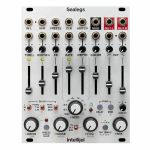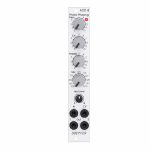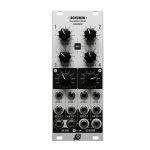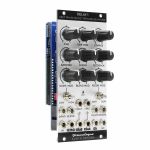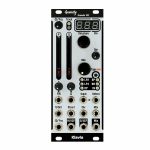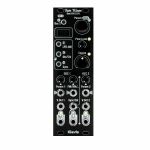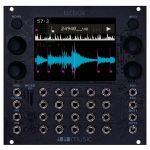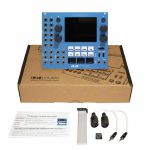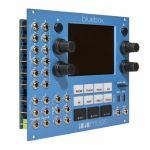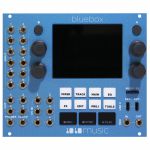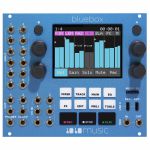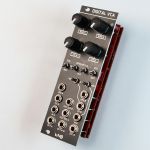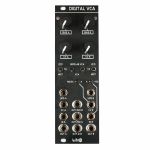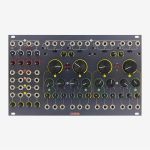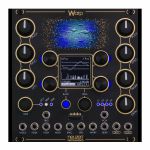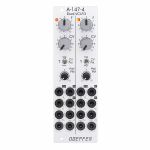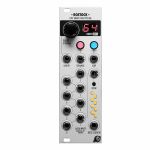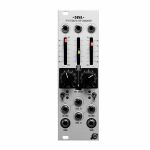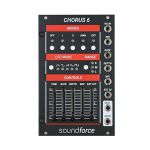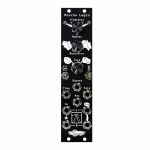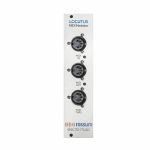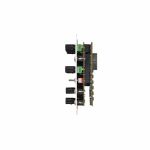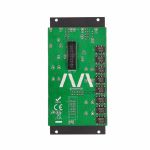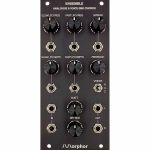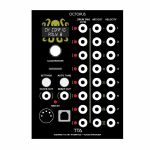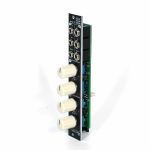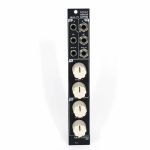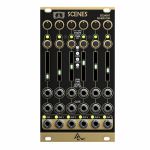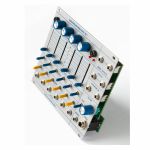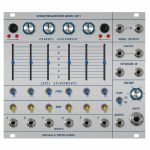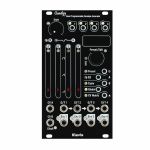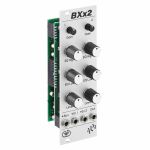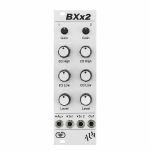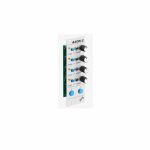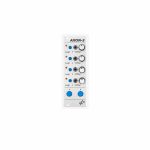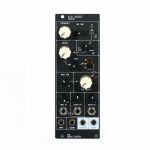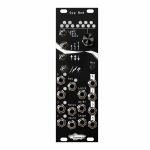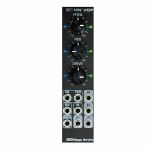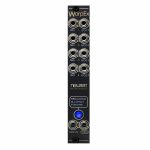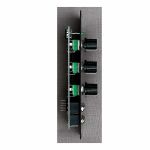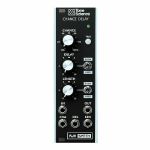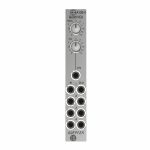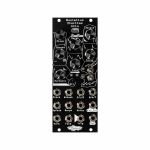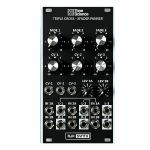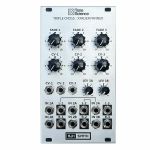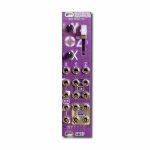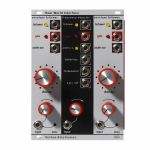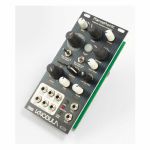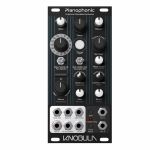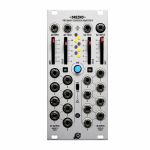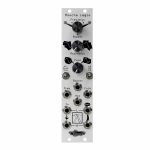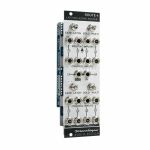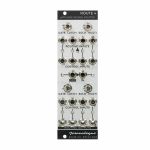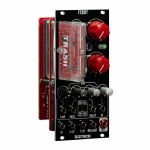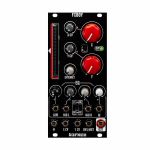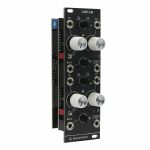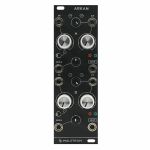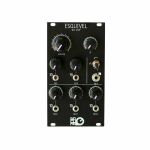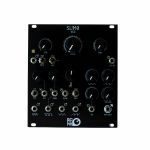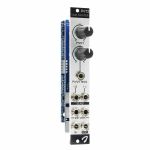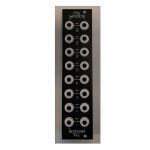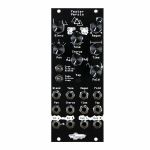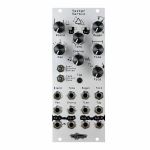100% Compra Segura
Studio equipment
Our full range of studio equipment from all the leading equipment and software brands. Guaranteed fast delivery and low prices.
100% Compra Segura
DJ equipment
Our full range of DJ equipment from all the leading equipment and software brands. Guaranteed fast delivery and low prices. Visit Juno DJ
Filter
Stock
Coming Soon
Equipment
Format
Brand
Featured
Price
Tags
Intellijel Sealegs Multi-Mode Stereo Character Delay Module With Reverb (dual/stereo/delay/reverb synth module)
Cat: 966771 Rel: 08 Sep 23
Multi-mode stereo character delay module with reverb - 20HP.
Notes: Multi-model stereo delay with reverb, featuring tape, bucket brigade and crossfading digital models, plus saturation, filters, internal modulation plus tons of CV control. Vibey as hell.
Supplier's Notes:
It's all gone a bit wobbly
Intellijel's design goal for Sealegs was to create the warmest, most musical and organic delay module possible - something that would sweeten and enhance any audio one chose to feed into it. As such, great care has gone into modelling the most distinctive and desirable sonic characteristics of three different types of delay circuits: Tape; Bucket Brigade, and Crossfading Digital.
A plethora of onboard controls enable you to dial in exactly the sound you want; synced or un-synced delays times (for both left and right channels); a built-in modulator with seven morphing waveshapes, a Wow & Flutter emulation, and an envelope follower; plus dedicated low- and high-pass filters; built-in hiss & crackle noises; per-model colour controls; a spacious reverb; and a re-configurable signal flow through the unit. In addition, attenuverted modulation inputs abound - ensuring the delay ebbs and flows with your musical needs.
Features
Three Unique delay models with per-model "Color", modulation behaviour, and saturation/limiting
Three Stereo configurations (PONG, L/R, Time/Width)
Built-in modulator with multiple, morphing wave shapes
Lush, routable 1970s-inspired reverb
Noise control to introduce hiss and crackle.
Highpass and lowpass filters for filtered repeats
Input drive with level trim
Per-model Freeze functionality for holding the delay contents and looping
Delay times up to 6 sec (L channel) and 8 sec (R channel, Width adds 33% to Time)
9 CV inputs (with attenuverters)
Stable external clock syncing (or tap tempo)
96 kHz, 32-bit stereo floating point processing
Size: 20HP
Depth: 29mm
Power: 116mA @ +12V 10mA @ -12V
… Read moreSupplier's Notes:
It's all gone a bit wobbly
Intellijel's design goal for Sealegs was to create the warmest, most musical and organic delay module possible - something that would sweeten and enhance any audio one chose to feed into it. As such, great care has gone into modelling the most distinctive and desirable sonic characteristics of three different types of delay circuits: Tape; Bucket Brigade, and Crossfading Digital.
A plethora of onboard controls enable you to dial in exactly the sound you want; synced or un-synced delays times (for both left and right channels); a built-in modulator with seven morphing waveshapes, a Wow & Flutter emulation, and an envelope follower; plus dedicated low- and high-pass filters; built-in hiss & crackle noises; per-model colour controls; a spacious reverb; and a re-configurable signal flow through the unit. In addition, attenuverted modulation inputs abound - ensuring the delay ebbs and flows with your musical needs.
Features
Three Unique delay models with per-model "Color", modulation behaviour, and saturation/limiting
Three Stereo configurations (PONG, L/R, Time/Width)
Built-in modulator with multiple, morphing wave shapes
Lush, routable 1970s-inspired reverb
Noise control to introduce hiss and crackle.
Highpass and lowpass filters for filtered repeats
Input drive with level trim
Per-model Freeze functionality for holding the delay contents and looping
Delay times up to 6 sec (L channel) and 8 sec (R channel, Width adds 33% to Time)
9 CV inputs (with attenuverters)
Stable external clock syncing (or tap tempo)
96 kHz, 32-bit stereo floating point processing
Size: 20HP
Depth: 29mm
Power: 116mA @ +12V 10mA @ -12V
6 in stock $412.05
Doepfer A-101-8 Photo Phasing 8-Stage Phase Shifter Module (silver) (phase shifter/effect synth module)
Cat: 945411 Rel: 13 Jun 23
An eight stage phase shifter module in 4HP.
Notes: Module A-101-8 is a 8-stage phase shifter which uses light-sensitive resistors (LDR) and is a replica of the Compact Phasing A manufactured by the company Schulte in the seventies. The actual phasing circuit is identical to the historic model. Only the illumination control of the LDRs is different: the A-101-8 uses LEDs to illuminate the LDRs, the historic model used incandescent miniature lamps. And the A-101-8 has no built-in LFO but can be controlled by any external control voltage source (e.g. LFO, ADSR, random, Theremin, ribbon controller, sequencer, midi). The phasing offset (i.e. the base value for the phase shifting) and the modulation depth of the external control signal can be adjusted separately. The Compact Phasing A had no offset control but only a depth control for the built-in LFO. Feedback and mixing ratio of the output signal are set by two controls. The audio input is equipped with an attenuator. The module has two audio outputs available (same as the historic model) and a visual display of the phase shifting.
The module has these controls and in/outputs available:
Control Man. : manual control of the phase shift offset (base value)
Control CV: attenuator for the signal applied to the CV socket
Control Feedb.: Feedback or Resonance (similar function as filter resonance/feedback/emphasis)
Control Mix: sets the mixing ratio between original and phase shift signal appearing at output 1
fully CCW: only the modified input signal appears at output 1 (see note below *)
center: a mixture between the modified input signal and the phase shift signal appears at output 1, that's the standard position for the classical phasing effect
fully CW: the pure phase shifted signal appears at output 1 (e.g. for vibrato effects)
Control Input Level: attenuator for signal applied to the In socket
Socket In: audio input
Socket CV: control voltage input
Socket Out 1: audio output 1 (mix signal)
Socket Out 2: audio output 2 (modified input signal)
LED: visual control of the phase shift
The module has some peculiarities (same as the historic model):
The input signal is processed at first by a pre-stage which outputs a "modified" input signal (*). This signal is not processed by the phase shift stages but is affected by the feedback setting. Only when feedback is set to zero this signal is identical to the input signal. Otherwise it contains feedback components.
This signal is output on socket Out 2.
When both output sockets Out 1 and Out 2 are used as stereo channels one obtains a spatial stereo sound effect.
The same signals is also used for the CCW position of the mix control. With mix control fully CCW the unmodified signal appears only if the feedback control is set to zero. Otherwise it contains feedback components.
The historic model had two audio inputs: one 5-pin DIN socket and a 1/4" jack socket. The DIN socket was intended for high-level line signals. When the 1/4" jack socket was used the amplification of the pre-stage increased by about 100. The 1/4" jack socket was intended for low level signals (e.g. electric guitars or microphones). For this feature the A-101-8 has an internal jumper that can be used to increase the amplification. As long as the module is used within the A-100 system usually the lower amplification is used to avoid distortion.
The 8 photo resistors and LEDs are assembled within an small lighproof box. In addition the pc boards are made of lighproof black material to avoid interfering light from other modules or the bus board.
Dimensions
4 HP
45 mm deep
Current Draw
30 mA +12V
30 mA -12V
… Read moreThe module has these controls and in/outputs available:
Control Man. : manual control of the phase shift offset (base value)
Control CV: attenuator for the signal applied to the CV socket
Control Feedb.: Feedback or Resonance (similar function as filter resonance/feedback/emphasis)
Control Mix: sets the mixing ratio between original and phase shift signal appearing at output 1
fully CCW: only the modified input signal appears at output 1 (see note below *)
center: a mixture between the modified input signal and the phase shift signal appears at output 1, that's the standard position for the classical phasing effect
fully CW: the pure phase shifted signal appears at output 1 (e.g. for vibrato effects)
Control Input Level: attenuator for signal applied to the In socket
Socket In: audio input
Socket CV: control voltage input
Socket Out 1: audio output 1 (mix signal)
Socket Out 2: audio output 2 (modified input signal)
LED: visual control of the phase shift
The module has some peculiarities (same as the historic model):
The input signal is processed at first by a pre-stage which outputs a "modified" input signal (*). This signal is not processed by the phase shift stages but is affected by the feedback setting. Only when feedback is set to zero this signal is identical to the input signal. Otherwise it contains feedback components.
This signal is output on socket Out 2.
When both output sockets Out 1 and Out 2 are used as stereo channels one obtains a spatial stereo sound effect.
The same signals is also used for the CCW position of the mix control. With mix control fully CCW the unmodified signal appears only if the feedback control is set to zero. Otherwise it contains feedback components.
The historic model had two audio inputs: one 5-pin DIN socket and a 1/4" jack socket. The DIN socket was intended for high-level line signals. When the 1/4" jack socket was used the amplification of the pre-stage increased by about 100. The 1/4" jack socket was intended for low level signals (e.g. electric guitars or microphones). For this feature the A-101-8 has an internal jumper that can be used to increase the amplification. As long as the module is used within the A-100 system usually the lower amplification is used to avoid distortion.
The 8 photo resistors and LEDs are assembled within an small lighproof box. In addition the pc boards are made of lighproof black material to avoid interfering light from other modules or the bus board.
Dimensions
4 HP
45 mm deep
Current Draw
30 mA +12V
30 mA -12V
7 in stock $124.03
Click for better price!
or call +44 20 7424 1960
quote 945411
quote 945411
Xaoc Devices Bohumin 1966 Mixing Console Commander Module (expander module)
Cat: 945623 Rel: 10 Oct 23
An expander module for the Ostrawa full stereo mixer in 10HP.
Notes: Part of Xaoc's range of modular mixing tools, the Bohumin 1966 is a commander module for Ostrawa stereo mixer modules, adding a second stereo aux bus, voltage control and manual attenuators with clickless mutes
Supplier's notes:
Bohumin [bo'xumin] is an expander for Xoac Deives' Ostrawa full stereo mixer module. By connecting to Bohumin, Ostrawa gains a second full stereo AUX bus with voltage control over the amount of the effect on each channel. Bohumin features manual attenuators for stereo returns of both AUX A and AUX B, as well as four gate inputs for automated clickless muting of each stereo input channel. Please note that Bohumin is not compatible with Ostrawa's sister module Praga. Similarly, Praga's expander Hrad cannot be connected to Ostrawa. However it is possible to chain any combination of Ostrawas and Pragas, and each of them may have its corresponding expander attached.
Technical details
10hp, skiff friendly
Power drawn from Ostrawa: +50mA/-40mA
… Read moreSupplier's notes:
Bohumin [bo'xumin] is an expander for Xoac Deives' Ostrawa full stereo mixer module. By connecting to Bohumin, Ostrawa gains a second full stereo AUX bus with voltage control over the amount of the effect on each channel. Bohumin features manual attenuators for stereo returns of both AUX A and AUX B, as well as four gate inputs for automated clickless muting of each stereo input channel. Please note that Bohumin is not compatible with Ostrawa's sister module Praga. Similarly, Praga's expander Hrad cannot be connected to Ostrawa. However it is possible to chain any combination of Ostrawas and Pragas, and each of them may have its corresponding expander attached.
Technical details
10hp, skiff friendly
Power drawn from Ostrawa: +50mA/-40mA
2 in stock $233.52
Joranalogue Delay 1 Split-Phase Bucket Brigade Delay Line Module (effect synth module)
Cat: 881426 Rel: 10 Aug 23
Delay 1 is a fully analogue BBD-based delay module with a multitude of features geared towards modern musical use.
Notes: Bucket brigade delay gets pushed into exciting creative territory with this beauty from Joranalogue. Precise analogue delay with loads of character, capable of simple chorus and flanger or more exotic Karplus-Strong synthesis and comb filtering.
Supplier's Notes:
While digital audio processors are often plagued by latency issues, analogue circuits are known for their instant response. But what if you want to delay a signal on purpose, without the use of tape or digital memory? Enter the bucket brigade delay (BBD) line: a series of capacitor 'buckets', which pass the incoming signal along at a high rate in order to delay it.
Delay 1 is a fully analogue BBD-based delay module with a multitude of features geared towards modern musical use. An integrated temperature-compensated, high-frequency voltage controlled oscillator (VCO) provides the 'clock' signal necessary to drive the delay line within 1 to 50 ms.
By increasing the drive frequency to over 20 kHz, the classic 'BBD clock whine' problem is solved, while still providing a wide range in delay time. Classic chorus, flanger and echo effects are easily achieved using the dry/wet blend, feedback and damping parameters.
To greatly reduce distortion and noise, Delay 1 includes a newly developed control circuit. The improved fidelity is maintained at a multitude of signal levels by an integrated high-performance compander, while maintaining signal dynamics.
The module's 'split phase' topology provides two different dry/wet mixes, which may be used to convert mono signals to stereo, for complementary comb filtering and more.
Delay 1 also allows you to experiment with Karplus-Strong synthesis, an exciting technique to create string and percussion type sounds. This is made easy by an integrated noise transient generator, driven by the 'pluck' input, and by the clock VCO's 1 volt per octave response.
By re-engineering the classic analogue delay line, Delay 1 brings the unique magic of BBDs into the contemporary electronic musician's arsenal.
Analogue bucket brigade delay line.
Integrated temperature-stable high-frequency BBD clock VCO with fine and coarse tuning.
Split-phase topology with additive and subtractive dry/wet blend outputs.
Blend, feedback and damping (feedback filter) parameters. Positive or negative feedback with low or high pass filtering.
High-performance BBD drive circuitry and transparent compander chain ensure optimal signal fidelity.
Dedicated pluck trigger input for Karplus-Strong synthesis.
High-frequency BBD clock input and output to synchronise multiple delay lines.
Impedance-compensated outputs with dual-colour LEDs.
Trim potentiometer accessible from the front panel.
Premium mounting hardware: black screws, black nylon washers and matching hex key.
High-quality components and assembly; designed and made in Belgium.
12 HP | +12: 125 mA, -12: 95 mA
… Read moreSupplier's Notes:
While digital audio processors are often plagued by latency issues, analogue circuits are known for their instant response. But what if you want to delay a signal on purpose, without the use of tape or digital memory? Enter the bucket brigade delay (BBD) line: a series of capacitor 'buckets', which pass the incoming signal along at a high rate in order to delay it.
Delay 1 is a fully analogue BBD-based delay module with a multitude of features geared towards modern musical use. An integrated temperature-compensated, high-frequency voltage controlled oscillator (VCO) provides the 'clock' signal necessary to drive the delay line within 1 to 50 ms.
By increasing the drive frequency to over 20 kHz, the classic 'BBD clock whine' problem is solved, while still providing a wide range in delay time. Classic chorus, flanger and echo effects are easily achieved using the dry/wet blend, feedback and damping parameters.
To greatly reduce distortion and noise, Delay 1 includes a newly developed control circuit. The improved fidelity is maintained at a multitude of signal levels by an integrated high-performance compander, while maintaining signal dynamics.
The module's 'split phase' topology provides two different dry/wet mixes, which may be used to convert mono signals to stereo, for complementary comb filtering and more.
Delay 1 also allows you to experiment with Karplus-Strong synthesis, an exciting technique to create string and percussion type sounds. This is made easy by an integrated noise transient generator, driven by the 'pluck' input, and by the clock VCO's 1 volt per octave response.
By re-engineering the classic analogue delay line, Delay 1 brings the unique magic of BBDs into the contemporary electronic musician's arsenal.
Analogue bucket brigade delay line.
Integrated temperature-stable high-frequency BBD clock VCO with fine and coarse tuning.
Split-phase topology with additive and subtractive dry/wet blend outputs.
Blend, feedback and damping (feedback filter) parameters. Positive or negative feedback with low or high pass filtering.
High-performance BBD drive circuitry and transparent compander chain ensure optimal signal fidelity.
Dedicated pluck trigger input for Karplus-Strong synthesis.
High-frequency BBD clock input and output to synchronise multiple delay lines.
Impedance-compensated outputs with dual-colour LEDs.
Trim potentiometer accessible from the front panel.
Premium mounting hardware: black screws, black nylon washers and matching hex key.
High-quality components and assembly; designed and made in Belgium.
12 HP | +12: 125 mA, -12: 95 mA
6 in stock $254.28
Klavis Grainity Digitally-Controlled Full-Analogue Path Granular & Multi-Mode VCF Module (silver) (filter/phase shifter/pitch shifter module)
Cat: 934965 Rel: 19 Dec 23
Digitally-controlled full-analogue path granular & multi-mode VCF module in 10HP.
Notes: A unique analogue take on granular synthesis, inspired by Yannis Xenakis, the Grainity pairs a granular filter with a multimode filter to create new textures and harmonics.
Supplier's Notes:
The Grainity brings a unique and never-heard-before concept to the world of analogue VCF.
While being based on analogue filtering only, the Grainity expands and enriches the sound in creating subharmonics, harmonies, unison, flanging effects and formant filtering all at once.
The module presents two sections, the granular filter itself and a typical multimode filter, each with its own output.
A third output offers a mix of both filter paths. Numerous controls and CV allow a very wide palette of results.
What is the Grainity
Granular?
The word granular was chosen for this filter module in relation to the concept invented by the composer Yannis Xenakis, and which is described as assembling small chops of sounds - he called grains - according to a pattern.
This is exactly what the Grainity does, no more no less ... but, digital control allows doing it in ways that are decades away from what tape and scissors allowed at the time.
Technology wise ...
In the granular section, the incoming sound cycle is determined in order to step through various filtering and phase variations of itself according to predefined patterns called structures.
The controls allow alterations to the cycling phase, cycling frequency offset (tuning), structure selection and frequency division of the filters cycling. This comes in addition to the usual filter frequency and resonance controls.
What the Grainity is not
Technology wise ...
Despite relying on a microprocessor, the Grainity is not a digital audio processor. At any time, the sound remains in the analog domain and goes through analog circuits from in to out.
The digital processor does not convert or generate audio signals; it is there to control the analog circuitry and manage the interface and display.
Sound wise ...
Several digital modules offering granular processing rely on the layering of sound grains, which leads to blurry and cloudy textures.
Layering of the grains is a late addition to the concept of granular synthesis and is not a mandatory feature of the concept.
The Grainity does not use delay lines or sampling memory but is nevertheless true to the foundations of the granular synthesis concept.
The granular VCF in the Grainity is unconventional in that, most of times, it is not filtering the sound in the common expectation of removing something. Typically, the granular process adds more than it removes by expanding both the lower range, creating subharmonics, and the upper harmonic contents in multiples ways.
Dimensions
10 HP
21 mm deep
Current Draw
101 mA +12V
59 mA -12V
… Read moreSupplier's Notes:
The Grainity brings a unique and never-heard-before concept to the world of analogue VCF.
While being based on analogue filtering only, the Grainity expands and enriches the sound in creating subharmonics, harmonies, unison, flanging effects and formant filtering all at once.
The module presents two sections, the granular filter itself and a typical multimode filter, each with its own output.
A third output offers a mix of both filter paths. Numerous controls and CV allow a very wide palette of results.
What is the Grainity
Granular?
The word granular was chosen for this filter module in relation to the concept invented by the composer Yannis Xenakis, and which is described as assembling small chops of sounds - he called grains - according to a pattern.
This is exactly what the Grainity does, no more no less ... but, digital control allows doing it in ways that are decades away from what tape and scissors allowed at the time.
Technology wise ...
In the granular section, the incoming sound cycle is determined in order to step through various filtering and phase variations of itself according to predefined patterns called structures.
The controls allow alterations to the cycling phase, cycling frequency offset (tuning), structure selection and frequency division of the filters cycling. This comes in addition to the usual filter frequency and resonance controls.
What the Grainity is not
Technology wise ...
Despite relying on a microprocessor, the Grainity is not a digital audio processor. At any time, the sound remains in the analog domain and goes through analog circuits from in to out.
The digital processor does not convert or generate audio signals; it is there to control the analog circuitry and manage the interface and display.
Sound wise ...
Several digital modules offering granular processing rely on the layering of sound grains, which leads to blurry and cloudy textures.
Layering of the grains is a late addition to the concept of granular synthesis and is not a mandatory feature of the concept.
The Grainity does not use delay lines or sampling memory but is nevertheless true to the foundations of the granular synthesis concept.
The granular VCF in the Grainity is unconventional in that, most of times, it is not filtering the sound in the common expectation of removing something. Typically, the granular process adds more than it removes by expanding both the lower range, creating subharmonics, and the upper harmonic contents in multiples ways.
Dimensions
10 HP
21 mm deep
Current Draw
101 mA +12V
59 mA -12V
5 in stock $257.40
Klavis Twin Waves MK2 Voltage-Controlled Dual VCO/LFO/Random Module (black) (digital/LFO/oscillator/dual/stereo/noise/quantizer/ring modulator/random synth module)
Cat: 951618 Rel: 26 Feb 24
Voltage-controlled dual VCO, LFO and random module - 8HP.
Notes: Two oscillators independently set as VCO, LFO, or random generator
This new version replaces the original Twin Waves. All features of the former are retained. You can check all videos, reviews and comments of V1, being sure to benefit of all in the MKII version :-)
Features in VCO mode:
V/Oct tracking over 10 octaves
Tuning lock with octave selection
Through zero and linear FM
Sub-octave output
Hard & soft synchronization
VCA control and CV algorithms selection
Quantizer with various scales
20 algorithm-based synthesis types among:
Wave shaping
Phase modulation
Phase positioning of multiple waves
Up to 5 stacked oscillators in tunable unison
Self-sync with phantom oscillator
Additive synthesis (7 waves)
Variable bit reduction (bit-crushing)
Ring modulator with its own 2nd oscillator
Noise with LPF, BPF, or resonant filter
Features in LFO mode:
Simultaneous signal and trigger outputs
External wave synchronization
Clock controlled rate with voltage controlled multiplier and divider
CV and knob control of output level
Algorithm based wave engine with a selection of:
Wave shaping
Phase modulation
Random levels and vectors (also Brownian)
Randomly spaced triggers and waves
Display with contextual icons and instant reminder help text
LEDs indicating potentiometer vs. value matching, switch settings and output signals
Automatically saved settings for instant recall at power on
Firmware update by playing an audio file via the front panel
Compact and skiff-friendly module
Dimensions
8 HP
21 mm deep
Current Draw
52 mA +12V
17 mA -12V
0 mA 5V
… Read moreThis new version replaces the original Twin Waves. All features of the former are retained. You can check all videos, reviews and comments of V1, being sure to benefit of all in the MKII version :-)
Features in VCO mode:
V/Oct tracking over 10 octaves
Tuning lock with octave selection
Through zero and linear FM
Sub-octave output
Hard & soft synchronization
VCA control and CV algorithms selection
Quantizer with various scales
20 algorithm-based synthesis types among:
Wave shaping
Phase modulation
Phase positioning of multiple waves
Up to 5 stacked oscillators in tunable unison
Self-sync with phantom oscillator
Additive synthesis (7 waves)
Variable bit reduction (bit-crushing)
Ring modulator with its own 2nd oscillator
Noise with LPF, BPF, or resonant filter
Features in LFO mode:
Simultaneous signal and trigger outputs
External wave synchronization
Clock controlled rate with voltage controlled multiplier and divider
CV and knob control of output level
Algorithm based wave engine with a selection of:
Wave shaping
Phase modulation
Random levels and vectors (also Brownian)
Randomly spaced triggers and waves
Display with contextual icons and instant reminder help text
LEDs indicating potentiometer vs. value matching, switch settings and output signals
Automatically saved settings for instant recall at power on
Firmware update by playing an audio file via the front panel
Compact and skiff-friendly module
Dimensions
8 HP
21 mm deep
Current Draw
52 mA +12V
17 mA -12V
0 mA 5V
3 in stock $232.49
1010 Music Bitbox Mk2 Sampler/Looper/Slicer/Recorder Module (black) (sampling synth module)
Cat: 958547 Rel: 24 Jul 23
Sampler, looper, slicer and recorder module - 26HP.
Notes: Second-generation version of 1010's outstanding Bitbox sampler module, featuring improved processing power, higher-quality touchscreen and new effects.
Supplier's Notes:
Next Generation Sampling Module for Eurorack
The bitbox mk2 is a follow up to 1010's successful bitbox module. Do more with bitbox mk2's more powerful processor and improved touch screen. This module has all of the features of the original bitbox and adds effects and mixing capabilities that take advantage of the faster and more powerful processor.
Sample Playback
Play up to 24 polyphonic notes when your samples fit in the 64 MB of internal memory or up to 8 larger samples streaming directly from the microSD card
Configure 16 sample pads per preset as single or multi-samples, clips, slicers, granular or new recordings
Stream long samples from the microSD card with a max sample size of 4 GB, which can be many hours of audio
Trigger samples with the touch screen, CV gate inputs, or MIDI input
Use MIDI for polyphonic playback of samples or slices
Control how samples start and stop by choosing from one-shot, toggle, and gate launch modes
Tweak playback through a variety of sample parameters, including start position, length, pitch, gain, filter, loop mode, launch quantization, ADSR, Exclusive Grouping, clip synchronization, slice placement and sequencing, grain size, grain spread, grain count, and MIDI note and channel mapping
Sample Recording
Record Eurorack level audio straight into the module:
Record samples from a stereo audio input pair
Configure each pad for stereo or mono recording with the option to synchronize the start and stop times to clock inputs
Trigger recording via audio level threshold
Create perfectly sized loops by setting the recording length
Enable immediate playback after recording for live looping capabilities
Make recordings up to 4 hours in length
Store recorded samples as WAV files on the micro SD card then remove the card to transfer them to your computer
Sample Modes
Find creative ways of using your samples with our 5 sample playback modes:
Trigger one shots or launch loops using sample mode
Load a folder of samples into a sample mode pad to improve the quality of the pitch shifting when playing a sample chromatically or to trigger different samples with each note
Play time-synchronized loops with constant pitch time shifting in clip mode
Skip between slices of a WAV using slicer mode
Create rich textures and other worldly sounds with granular mode
External Control and Synchronization
Playback can be immediate or synchronized to internal clock, TRS clock in, or MIDI clock in and out
Trigger each pad independently through a dedicated gate input
Use MIDI to trigger pads via a note per pad
Play a single or multi-sample pad pitch shifted using MIDI notes or CV
Trigger different sample slices using MIDI notes or CV
Modulate a wide variety of sample parameters through the MIDI input and up to 8 CV signals
Quickly set up MIDI modulation using Learn mode - no need to look up CC numbers
Module Features
Use the 3.5" diagonal touch screen to intuitively explore the features of the module
Get more creative with double the processing power of the original bitbox
Fill out your sound with reverb and delay
Import or export WAV files with your Mac or PC using a microSD card
Save and recall multiple presets
Increase your capacity with larger microSD cards
Select Flipped UI mode to mount the unit with the screen on the bottom and use the screen, knobs, buttons, and CV jacks as you normally would
When you purchase a bitbox mk2, you will receive:
a bitbox mk2 Eurorack module
a microSD card with with a bank of demo presets and samples loaded on it
a Eurorack power cable
a bitbox mk2 Quick Start guide
a MIDI Adapter
Technical Specs
Supports 1 and 2 channel WAV files with 16, 24 or 32-bit resolution at any sample rate (48kHz preferred)
26 HP
Module dimensions including knobs: 5.25" x 5"x 1.75"
Depth behind front panel with ribbon cable: 1.25"
+12V: 400mA
-12V: 0mA
5V: 0mA
24-bit ADC and DAC
Inputs and Outputs
Connect up to 8 CV modulators to control numerous sample parameters
Trigger each of the 16 pads with a dedicated gate input
Record through the dedicated stereo audio input pair
Use CV to keep time through the dedicated clock input
Confidently connect with both TRS MIDI Type A and Type B, no adapter needed
Route the audio from each pad out to one of 2 stereo audio output pairs or any of the corresponding single channels
Inputs and outputs are DC coupled so you can record and play out CV signals
… Read moreSupplier's Notes:
Next Generation Sampling Module for Eurorack
The bitbox mk2 is a follow up to 1010's successful bitbox module. Do more with bitbox mk2's more powerful processor and improved touch screen. This module has all of the features of the original bitbox and adds effects and mixing capabilities that take advantage of the faster and more powerful processor.
Sample Playback
Play up to 24 polyphonic notes when your samples fit in the 64 MB of internal memory or up to 8 larger samples streaming directly from the microSD card
Configure 16 sample pads per preset as single or multi-samples, clips, slicers, granular or new recordings
Stream long samples from the microSD card with a max sample size of 4 GB, which can be many hours of audio
Trigger samples with the touch screen, CV gate inputs, or MIDI input
Use MIDI for polyphonic playback of samples or slices
Control how samples start and stop by choosing from one-shot, toggle, and gate launch modes
Tweak playback through a variety of sample parameters, including start position, length, pitch, gain, filter, loop mode, launch quantization, ADSR, Exclusive Grouping, clip synchronization, slice placement and sequencing, grain size, grain spread, grain count, and MIDI note and channel mapping
Sample Recording
Record Eurorack level audio straight into the module:
Record samples from a stereo audio input pair
Configure each pad for stereo or mono recording with the option to synchronize the start and stop times to clock inputs
Trigger recording via audio level threshold
Create perfectly sized loops by setting the recording length
Enable immediate playback after recording for live looping capabilities
Make recordings up to 4 hours in length
Store recorded samples as WAV files on the micro SD card then remove the card to transfer them to your computer
Sample Modes
Find creative ways of using your samples with our 5 sample playback modes:
Trigger one shots or launch loops using sample mode
Load a folder of samples into a sample mode pad to improve the quality of the pitch shifting when playing a sample chromatically or to trigger different samples with each note
Play time-synchronized loops with constant pitch time shifting in clip mode
Skip between slices of a WAV using slicer mode
Create rich textures and other worldly sounds with granular mode
External Control and Synchronization
Playback can be immediate or synchronized to internal clock, TRS clock in, or MIDI clock in and out
Trigger each pad independently through a dedicated gate input
Use MIDI to trigger pads via a note per pad
Play a single or multi-sample pad pitch shifted using MIDI notes or CV
Trigger different sample slices using MIDI notes or CV
Modulate a wide variety of sample parameters through the MIDI input and up to 8 CV signals
Quickly set up MIDI modulation using Learn mode - no need to look up CC numbers
Module Features
Use the 3.5" diagonal touch screen to intuitively explore the features of the module
Get more creative with double the processing power of the original bitbox
Fill out your sound with reverb and delay
Import or export WAV files with your Mac or PC using a microSD card
Save and recall multiple presets
Increase your capacity with larger microSD cards
Select Flipped UI mode to mount the unit with the screen on the bottom and use the screen, knobs, buttons, and CV jacks as you normally would
When you purchase a bitbox mk2, you will receive:
a bitbox mk2 Eurorack module
a microSD card with with a bank of demo presets and samples loaded on it
a Eurorack power cable
a bitbox mk2 Quick Start guide
a MIDI Adapter
Technical Specs
Supports 1 and 2 channel WAV files with 16, 24 or 32-bit resolution at any sample rate (48kHz preferred)
26 HP
Module dimensions including knobs: 5.25" x 5"x 1.75"
Depth behind front panel with ribbon cable: 1.25"
+12V: 400mA
-12V: 0mA
5V: 0mA
24-bit ADC and DAC
Inputs and Outputs
Connect up to 8 CV modulators to control numerous sample parameters
Trigger each of the 16 pads with a dedicated gate input
Record through the dedicated stereo audio input pair
Use CV to keep time through the dedicated clock input
Confidently connect with both TRS MIDI Type A and Type B, no adapter needed
Route the audio from each pad out to one of 2 stereo audio output pairs or any of the corresponding single channels
Inputs and outputs are DC coupled so you can record and play out CV signals
2 in stock $597.83
1010 Music Bluebox Digital Mixer & Recorder Module With Effects (mixer synth module)
Cat: 970244 Rel: 23 Oct 23
Mixer module with effects and multi-channel recording/playback - 30HP.
Notes: Eurorack version of 1010's superb Bluebox. Vast power in 30 HP, with the ability to mix, record and play back in mono and stereo, hook up to a computer over USB for stereo I/O and run effects, all with CV control.
Supplier's Notes:
The bluebox Eurorack edition is the new Eurorack mixer with effects and multichannel recording/playback based on the award-winning bluebox desktop mixer. With the Eurorack edition's USB-C EXT port, you can send 2 channels of audio to and from your computer. Plus, you can control up to 6 mix settings with the 6 CV inputs. Whether recording your Eurorack jams, using it to play stems as backing tracks, or a combination of both - bluebox Eurorack edition will rock your rack!
Connect your eurorack, sampler, drum machine, and synthesizer outputs to 12 mono, 3.5 mm inputs and map them to 12 mono tracks or 6 stereo tracks - all with independent control for recording and playback. Connect your computer to the USB C port to send and receive two channels of audio.
The bluebox Eurorack edition is the ultimate in compact mixing, effects, recording, and playback for Eurorack. Smack it in your rack and hit the road with a self-contained, electronic music powerhouse!
When you purchase a bluebox Eurorack edition, you will receive:
a bluebox Eurorack edition 30 HP Eurorack module
A microSD card with bluebox firmware and pre-loaded project files
two Eurorack power cables
a bluebox Eurorack edition Quick Start guide
two MIDI Adapters
Technical Specs
Dimensions & Power
30 HP
Module dimensions including knobs: 6" x 5"x 1.6"
Depth behind front panel with ribbon cable: 1.0"
Requires the +5V rail which may not be present
on some older racks.
Uses 500-850mA at +5V (depending
on screen brightness), 320 mA at +12V, and 82mA at -12V
Requires two power connections
Capabilities
12 mono tracks, 6 stereo tracks or something in between
Connect to TRS or USB C MIDI for beat syncing effects
Lots of headroom with support for Eurorack levels up to +/-5V inputs and outputs
3 effects: reverb, delay and compressor
Records and plays back 48k, 24-bit audio WAV files
4 band EQ per track
Durable aluminum faceplate
Stream 2 channels of audio in and out over USB C
Inputs and Outputs
12 mono 3.5 mm TS inputs
2 independently controlled 3.5 mm TS output pairs that can be used as 4 mono outputs
1 stereo 3.5 mm headphone output
6 CV Inputs
1 USB C MIDI Device port
1 TRS MIDI Input
1 TRS MIDI Output
1 USB C Ext jack for streaming audio
3.5" touch screen, 4 knobs, 8 navigation buttons and 3 transport buttons
… Read moreSupplier's Notes:
The bluebox Eurorack edition is the new Eurorack mixer with effects and multichannel recording/playback based on the award-winning bluebox desktop mixer. With the Eurorack edition's USB-C EXT port, you can send 2 channels of audio to and from your computer. Plus, you can control up to 6 mix settings with the 6 CV inputs. Whether recording your Eurorack jams, using it to play stems as backing tracks, or a combination of both - bluebox Eurorack edition will rock your rack!
Connect your eurorack, sampler, drum machine, and synthesizer outputs to 12 mono, 3.5 mm inputs and map them to 12 mono tracks or 6 stereo tracks - all with independent control for recording and playback. Connect your computer to the USB C port to send and receive two channels of audio.
The bluebox Eurorack edition is the ultimate in compact mixing, effects, recording, and playback for Eurorack. Smack it in your rack and hit the road with a self-contained, electronic music powerhouse!
When you purchase a bluebox Eurorack edition, you will receive:
a bluebox Eurorack edition 30 HP Eurorack module
A microSD card with bluebox firmware and pre-loaded project files
two Eurorack power cables
a bluebox Eurorack edition Quick Start guide
two MIDI Adapters
Technical Specs
Dimensions & Power
30 HP
Module dimensions including knobs: 6" x 5"x 1.6"
Depth behind front panel with ribbon cable: 1.0"
Requires the +5V rail which may not be present
on some older racks.
Uses 500-850mA at +5V (depending
on screen brightness), 320 mA at +12V, and 82mA at -12V
Requires two power connections
Capabilities
12 mono tracks, 6 stereo tracks or something in between
Connect to TRS or USB C MIDI for beat syncing effects
Lots of headroom with support for Eurorack levels up to +/-5V inputs and outputs
3 effects: reverb, delay and compressor
Records and plays back 48k, 24-bit audio WAV files
4 band EQ per track
Durable aluminum faceplate
Stream 2 channels of audio in and out over USB C
Inputs and Outputs
12 mono 3.5 mm TS inputs
2 independently controlled 3.5 mm TS output pairs that can be used as 4 mono outputs
1 stereo 3.5 mm headphone output
6 CV Inputs
1 USB C MIDI Device port
1 TRS MIDI Input
1 TRS MIDI Output
1 USB C Ext jack for streaming audio
3.5" touch screen, 4 knobs, 8 navigation buttons and 3 transport buttons
3 in stock $672.56
Click for better price!
or call +44 20 7424 1960
quote 970244
quote 970244
Xaoc Devices Poti II 1974 Batumi II Expander Module (expander module)
Cat: 979277 Rel: 29 Feb 24
Expander module for Batumi II - 4HP
Notes: Poti II expander notable features:
- per-channel input and output attenuation for the SINE and ASSGN outputs
- per-channel shape modulation with switchable destination (wave folding, shape switching, PWM)
- stores settings during a power cycle
- LED indication of the discrepancy between the stored setting and current pot position
- 4HP
- +10/-0mA from Batumi II
… Read more- per-channel input and output attenuation for the SINE and ASSGN outputs
- per-channel shape modulation with switchable destination (wave folding, shape switching, PWM)
- stores settings during a power cycle
- LED indication of the discrepancy between the stored setting and current pot position
- 4HP
- +10/-0mA from Batumi II
1 in stock $85.11
Click for better price!
or call +44 20 7424 1960
quote 979277
quote 979277
WMD Digital VCA MKIII Dual Zero-Crossing VCA & Polariser Module (polariser/ring modulator/sample & hold/VCA module)
Cat: 1008017 Rel: 27 Mar 24
Dual digital VCA module with zero crossing detection, polarisation, noise, sample & hold - 8HP
Notes: Another update for WMD's clever dual VCA, this time a little bigger to give more control. Digital control of CV and attenuation gives lots of creative options. Third time's a charm.
Supplier's Notes:
WMD have done several designs of this circuit over the years, the first one had no knobs, the second was too small, the MKIII is finally how this circuit should be packaged. This module does some really cool stuff and is super useful in any system.
The Digital VCA lets signal through like a normal VCA, but the CV and attenuation level is controlled digitally. This lets us do things like wait until there is a zero crossing to change the amplitude, resulting in clickless amplitude changes.
The Trigger mode causes the VCA to only update when a trigger is received. The addition of a noise circuit for each side let us do a very quick and easy sample and hold that never droops. With no input, 5V is normaled to the attenuator, so you get a 0-5V sample and hold. In Bipolar mode, you can get -5 to +5V.
Both sides have bipolar VCA mode (polarizer), which lets them invert the signal when negative CV comes in. Also known as ring modulation. With the zero crossing detector, this can produce some super wild wave shapes.
Features
Dual VCA Design
Unipolar or Bipolar Operation
DC Coupled Analogue Signal Path
Low Distortion / Low Noise
VCA Closes Completely
Zero Crossing Detector Mode
Trigger Mode
Two Independent Noise Sources
8 bit CV resolution
Great for Fast Envelopes and Sine Bass Sounds
Specifications
Power: +65mA, -45mA
Width: 8HP
Depth: 35mm with cables
Height: Eurorack 3U (128.5mm)
Board Height Behind Panel: 112mm
CV/Signal Input Impedance: 100k
Output Impedance: 1k
UPD in 3.3V Threshold Schmitt Trigger
ZCD produces 15us 5V pulse
5V CV to fully open VCA
Linear VCA response
20Vpp signal handling
… Read moreSupplier's Notes:
WMD have done several designs of this circuit over the years, the first one had no knobs, the second was too small, the MKIII is finally how this circuit should be packaged. This module does some really cool stuff and is super useful in any system.
The Digital VCA lets signal through like a normal VCA, but the CV and attenuation level is controlled digitally. This lets us do things like wait until there is a zero crossing to change the amplitude, resulting in clickless amplitude changes.
The Trigger mode causes the VCA to only update when a trigger is received. The addition of a noise circuit for each side let us do a very quick and easy sample and hold that never droops. With no input, 5V is normaled to the attenuator, so you get a 0-5V sample and hold. In Bipolar mode, you can get -5 to +5V.
Both sides have bipolar VCA mode (polarizer), which lets them invert the signal when negative CV comes in. Also known as ring modulation. With the zero crossing detector, this can produce some super wild wave shapes.
Features
Dual VCA Design
Unipolar or Bipolar Operation
DC Coupled Analogue Signal Path
Low Distortion / Low Noise
VCA Closes Completely
Zero Crossing Detector Mode
Trigger Mode
Two Independent Noise Sources
8 bit CV resolution
Great for Fast Envelopes and Sine Bass Sounds
Specifications
Power: +65mA, -45mA
Width: 8HP
Depth: 35mm with cables
Height: Eurorack 3U (128.5mm)
Board Height Behind Panel: 112mm
CV/Signal Input Impedance: 100k
Output Impedance: 1k
UPD in 3.3V Threshold Schmitt Trigger
ZCD produces 15us 5V pulse
5V CV to fully open VCA
Linear VCA response
20Vpp signal handling
1 in stock $234.57
Click for better price!
or call +44 20 7424 1960
quote 1008017
quote 1008017
Frap Tools Cunsa Quad Analogue Pingable Multi-Mode Resonant Filter/Saturator/Mixer/Oscillator Module (effect/filter/mixer/oscillator/quad/VCA synth module)
Cat: 945399 Rel: 28 Nov 23
A quadruple analogue pingable multimode resonant filter, saturator, mixer and oscillator module in HP.
Notes: Oof. Frap casually serve up one of the best filters we've seen in a long time. Quad multimode circuits with saturation and feedback give you extensive routing options. Delicious.
Supplier's Notes:
cunsa /'cu?nsa/ s.f. [dialect of Modena of uncertain etymology, probably from a Latin *comptiare, derived from comptus, participle of comere 'organize,' 'decorate'] i curing, seasoning (of foods), tanning (of leathers).
Seasoning is crucial for cooking. It is a process that enhances the flavors, glues the ingredients together, and even adds some unexpected kick.
From a gentle refining touch to a shovelful of spice, CUNSA is the perfect seasoning tool for your patches. It can sweeten a sour lead or beef up an insipid bass line, and anything in between.
And, just like a good oil, you can even taste it by itself!
CUNSA is a quadruple analog pingable multimode resonant filter, saturator, mixer, and oscillator.
It is Frap Tools' sound seasoning tool: it can gently even a patch, applying a final touch, or it can set it on fire with a ridiculous amount of spice. It's up to you and your cooking style!
It consists of four multimode resonant filters with a custom saturation and feedback control that you can use independently or in various combinations and roles thanks to a series of seminormalizations.
Four Analogue Resonant Multimode Filters
CUNSA features four state-variable filters that can be used independently or linked and mixed. Each filter provides three behaviors simultaneously: lowpass, bandpass, and highpass. Each behavior has a 12 dB/oct slope, except for the lowpass, which can be either 12 or 24 dB/oct.
Unique 'Character' Circuit for Feedback and Distortion
CUNSA handles feedback and gain staging with extreme control and versatility. Besides the usual Q control that emphasizes the cutoff frequency, the Character circuit defines the amount of soft clipping when the filter overloads. High clipping guarantees a controlled behavior with fat tone and pure resonance, while low or no clipping lets the signal saturate the filter stages and make it scream.
V/oct Tracking and Quadruple Oscillator
Each filter responds to the V/oct signal with excellent tracking. It is thus possible to move the cutoff frequency along with the main melody or make CUNSA resonate with no input and transform it into a multiple oscillator. The V/oct inputs are seminormalled so you can control more filters with the same CV. Easy chords stabs!
Ping and Ring
CUNSA is ideal for percussive and organic tones. The Ping circuit offers a behavior similar to the BRENSO but AC-coupled. Instead of shooting the frequency to the moon with any trig, CUNSA gently responds to different incoming gates with a selectable decay curve. The Ping circuit can thus create natural decay sounds when fed with trigs or smoother envelopes with any other voltage, like a linear integrator with a custom decay.
Besides this, you can also feed the filter's audio input with trigs and make it ring at high Q settings.
Linked or Individual Filtering
The four filters can work independently or arranged in groups through seminormalled inputs and sum outputs. CUNSA can thus be a 4×1, 2×2, or a massive 1×4 filter. Even odd configurations are possible, like 1+2+1 or 3+1. Mono, stereo, or quadraphonic audio is at your fingertips.
Filter and Combo Behaviour
When the filter behavior is set to COMBINED, every control of the cutoff frequency also affects the input VCA, reducing the signal amplitude and saturation as it approaches the lowest range. It can make organic decays with the ping circuit or tame the low range at high Q and Character settings.
Four Seminormalizations for Group Use
Four inputs have a cascaded seminormalization: audio inputs, VCA CV, V/oct, and Ping. Every signal patched to a filter will thus feed also those at its right, making simultaneous use even simpler. To remove a seminormalization, simply patch a dummy cable to the corresponding input.
Analog Mixing Stage and Group Outputs
Every filter output can be routed to an analogue mix bus that sums the four filters and outputs them in three combinations: all, 1+2, and 3+4. These outputs allow for versatile audio processing. Just like we did with FUMANA, we added a gentle shelving EQ for the higher frequencies of the All output to provide additional timbral variety.
CV Inputs with Attenuators
Besides the seminormalled inputs, every filter features additional CV inputs for cutoff frequency, Q, and Character, each with a dedicated attenuverter.
… Read moreSupplier's Notes:
cunsa /'cu?nsa/ s.f. [dialect of Modena of uncertain etymology, probably from a Latin *comptiare, derived from comptus, participle of comere 'organize,' 'decorate'] i curing, seasoning (of foods), tanning (of leathers).
Seasoning is crucial for cooking. It is a process that enhances the flavors, glues the ingredients together, and even adds some unexpected kick.
From a gentle refining touch to a shovelful of spice, CUNSA is the perfect seasoning tool for your patches. It can sweeten a sour lead or beef up an insipid bass line, and anything in between.
And, just like a good oil, you can even taste it by itself!
CUNSA is a quadruple analog pingable multimode resonant filter, saturator, mixer, and oscillator.
It is Frap Tools' sound seasoning tool: it can gently even a patch, applying a final touch, or it can set it on fire with a ridiculous amount of spice. It's up to you and your cooking style!
It consists of four multimode resonant filters with a custom saturation and feedback control that you can use independently or in various combinations and roles thanks to a series of seminormalizations.
Four Analogue Resonant Multimode Filters
CUNSA features four state-variable filters that can be used independently or linked and mixed. Each filter provides three behaviors simultaneously: lowpass, bandpass, and highpass. Each behavior has a 12 dB/oct slope, except for the lowpass, which can be either 12 or 24 dB/oct.
Unique 'Character' Circuit for Feedback and Distortion
CUNSA handles feedback and gain staging with extreme control and versatility. Besides the usual Q control that emphasizes the cutoff frequency, the Character circuit defines the amount of soft clipping when the filter overloads. High clipping guarantees a controlled behavior with fat tone and pure resonance, while low or no clipping lets the signal saturate the filter stages and make it scream.
V/oct Tracking and Quadruple Oscillator
Each filter responds to the V/oct signal with excellent tracking. It is thus possible to move the cutoff frequency along with the main melody or make CUNSA resonate with no input and transform it into a multiple oscillator. The V/oct inputs are seminormalled so you can control more filters with the same CV. Easy chords stabs!
Ping and Ring
CUNSA is ideal for percussive and organic tones. The Ping circuit offers a behavior similar to the BRENSO but AC-coupled. Instead of shooting the frequency to the moon with any trig, CUNSA gently responds to different incoming gates with a selectable decay curve. The Ping circuit can thus create natural decay sounds when fed with trigs or smoother envelopes with any other voltage, like a linear integrator with a custom decay.
Besides this, you can also feed the filter's audio input with trigs and make it ring at high Q settings.
Linked or Individual Filtering
The four filters can work independently or arranged in groups through seminormalled inputs and sum outputs. CUNSA can thus be a 4×1, 2×2, or a massive 1×4 filter. Even odd configurations are possible, like 1+2+1 or 3+1. Mono, stereo, or quadraphonic audio is at your fingertips.
Filter and Combo Behaviour
When the filter behavior is set to COMBINED, every control of the cutoff frequency also affects the input VCA, reducing the signal amplitude and saturation as it approaches the lowest range. It can make organic decays with the ping circuit or tame the low range at high Q and Character settings.
Four Seminormalizations for Group Use
Four inputs have a cascaded seminormalization: audio inputs, VCA CV, V/oct, and Ping. Every signal patched to a filter will thus feed also those at its right, making simultaneous use even simpler. To remove a seminormalization, simply patch a dummy cable to the corresponding input.
Analog Mixing Stage and Group Outputs
Every filter output can be routed to an analogue mix bus that sums the four filters and outputs them in three combinations: all, 1+2, and 3+4. These outputs allow for versatile audio processing. Just like we did with FUMANA, we added a gentle shelving EQ for the higher frequencies of the All output to provide additional timbral variety.
CV Inputs with Attenuators
Besides the seminormalled inputs, every filter features additional CV inputs for cutoff frequency, Q, and Character, each with a dedicated attenuverter.
8 in stock $890.53
Neuzeit Instruments Warp Additive & Wavetable Synth Voice Module (dual/stereo/oscillator/synth voice module)
Cat: 945406 Rel: 06 Oct 23
An additive and wavetable synth voice module in 24HP.
Notes: Warp is a novel synth engine that combines the best of additive and wavetable synthesis.
In the center of Warp's control panel is a colorful XY LED matrix that represents the sound space from which Warp draws its sounds. This XY sound space consists of 32x16 frequency spectra. Each of Warp's four voices can move freely and independently across the XY space. It always uses the surrounding frequency spectra to calculate a wavetable based on 512 sine waves in real time using additive synthesis. By changing the position, wicked wavetable sounds are possible, playable with four voices and eight oscillators and navigable in two directions. An intuitive integrated editor allows playful modeling of your own frequency spectra.
With Warp's SPEC effects the frequency spectrum can be filtered and deformed in realtime before a wavetable is calculated. The wavetable can then be modified with WARP effects like wavefolder, PWM bend, overdrive and redux. The resulting wavetable serves as source for two oscillators per voice, which can be detuned and also synchronized to each other. Each voice is followed by a 12/24dB/octave high pass and low pass filter.
Warp offers an integrated editor, with which you can playfully draw and modify your own frequency spectra. The XY-Sound Space is seen as a canvas on which you can draw your own frequency peaks. Several drawing algorithms are available as tools to edit single or a group of harmonics in a musically meaningful way. There is also the possibility to derive frequency spectra from audio samples from the SD card or to put whole wavetable audio files into the XY sound space. Likewise, the XY sound space can be exported to the SD card as a wavetable audio file of any length and bit depth, so Warp can also be used as an intuitive wavetable generator for other synthesizers.
Also on board are two internal ADSR envelopes and two LFOs, which can be routed to a variety of internal destinations using a modulation matrix. To keep the overview, all modulations are color-coded and are additionally visualized by pulsating LEDs in the modulation matrix view.
Navigation through the menu is as intuitive as with our QUASAR module and is simply done via a push-encoder and a back button. The display always shows which function the four surrounding aluminum encoders currently have, and colored LEDs next to the encoders provide visual assistance. Likewise, the tuning of the module is done via a detented encoder, which adjusts the pitch either in fine steps, in semitones or in octaves. An octave switch is thus already integrated.
For all its feature-richness, Warp still remains a playable and performance-oriented instrument. The large potentiometers serve as macro controls to control several parameters under the hood at once. This keeps the instrument straight forward with a manageable number of controls, but they are all very expressive.
Likewise, the module offers the ability to save and load presets and also comes with audio files and presets on board. Thus, Warp is ideally suited for both detail-oriented sound design and hands-on performance.
In the standalone version, Warp is a monophonic four-voice synth voice that can also be used as an oscillator. With an expander module, it will also be possible to play Warp four-voice polyphonic via MIDI and CV/Gate in the future.
Warp uses a novel hybrid engine that combines the best of additive and wavetable synthesis. With the integrated editor you can playfully draw your own frequency spectra like on a canvas into the colorful XY sound palette. Warp is a feature-rich powerhouse that lets you create all kinds of sounds, from glassy clean to crunchy crunch. Thanks to expressive macro tone controls, extreme morphs are possible in a single pot turn.
Main functions
4 Voices & 2 oscillators using a hybrid additive-wavetable synth engine
Big knobs act as macro controls for underlying parameters and enable expressive Hands-On playability
Polyphonic with expander, monophonic as standalone unit
Usable as a full synth voice or as an oscillator module
Additive synthesis with 512 sine waves per oscillator = 4096 sine waves in total
XY sound space as a collection of 32x16 frequency spectra
Each voice travels independently across the XY space and uses the underlying spectra to synthesize a wavetable in real-time
Spectral FX are applied on the spectrum before a wavetable is generated
Wavetable FX are applied once the wavetable is generated, e.g. Wavefolder, PWM-Bend, Redux, Overdrive
Two Post-Filters per voice: 12/24dB Lowpass and Highpass with resonance control
Independent oscillator settings per voice, e.g. volume, pitch, stereo pan, detune, sync, X/Y position
Integrated modulation by 2x ADSR, 2x LFO with many waveforms
Modulation matrix view to see everything that is going on at once
Integrated editor for playful drawing of own frequency spectra
Algorithms for musically meaningful drawing of harmonics
Width: 24 HP
Depth: 30 mm
Current draw +12V: 205mA
Current draw -12V: 20 mA
Current draw +5V: 0 mA
** Includes 3mm screws, 16-Pin to 10-Pin eurorack power cable, USB cable for firmware updates **
Warp uses a novel hybrid engine that combines the best of additive and wavetable synthesis. With the integrated editor you can playfully draw your own frequency spectra like on a canvas into the colorful XY sound palette. Warp is a feature-rich powerhouse that lets you create all kinds of sounds, from glassy clean to crunchy crunch. Thanks to expressive macro tone controls, extreme morphs are possible in a single pot turn.
… Read moreIn the center of Warp's control panel is a colorful XY LED matrix that represents the sound space from which Warp draws its sounds. This XY sound space consists of 32x16 frequency spectra. Each of Warp's four voices can move freely and independently across the XY space. It always uses the surrounding frequency spectra to calculate a wavetable based on 512 sine waves in real time using additive synthesis. By changing the position, wicked wavetable sounds are possible, playable with four voices and eight oscillators and navigable in two directions. An intuitive integrated editor allows playful modeling of your own frequency spectra.
With Warp's SPEC effects the frequency spectrum can be filtered and deformed in realtime before a wavetable is calculated. The wavetable can then be modified with WARP effects like wavefolder, PWM bend, overdrive and redux. The resulting wavetable serves as source for two oscillators per voice, which can be detuned and also synchronized to each other. Each voice is followed by a 12/24dB/octave high pass and low pass filter.
Warp offers an integrated editor, with which you can playfully draw and modify your own frequency spectra. The XY-Sound Space is seen as a canvas on which you can draw your own frequency peaks. Several drawing algorithms are available as tools to edit single or a group of harmonics in a musically meaningful way. There is also the possibility to derive frequency spectra from audio samples from the SD card or to put whole wavetable audio files into the XY sound space. Likewise, the XY sound space can be exported to the SD card as a wavetable audio file of any length and bit depth, so Warp can also be used as an intuitive wavetable generator for other synthesizers.
Also on board are two internal ADSR envelopes and two LFOs, which can be routed to a variety of internal destinations using a modulation matrix. To keep the overview, all modulations are color-coded and are additionally visualized by pulsating LEDs in the modulation matrix view.
Navigation through the menu is as intuitive as with our QUASAR module and is simply done via a push-encoder and a back button. The display always shows which function the four surrounding aluminum encoders currently have, and colored LEDs next to the encoders provide visual assistance. Likewise, the tuning of the module is done via a detented encoder, which adjusts the pitch either in fine steps, in semitones or in octaves. An octave switch is thus already integrated.
For all its feature-richness, Warp still remains a playable and performance-oriented instrument. The large potentiometers serve as macro controls to control several parameters under the hood at once. This keeps the instrument straight forward with a manageable number of controls, but they are all very expressive.
Likewise, the module offers the ability to save and load presets and also comes with audio files and presets on board. Thus, Warp is ideally suited for both detail-oriented sound design and hands-on performance.
In the standalone version, Warp is a monophonic four-voice synth voice that can also be used as an oscillator. With an expander module, it will also be possible to play Warp four-voice polyphonic via MIDI and CV/Gate in the future.
Warp uses a novel hybrid engine that combines the best of additive and wavetable synthesis. With the integrated editor you can playfully draw your own frequency spectra like on a canvas into the colorful XY sound palette. Warp is a feature-rich powerhouse that lets you create all kinds of sounds, from glassy clean to crunchy crunch. Thanks to expressive macro tone controls, extreme morphs are possible in a single pot turn.
Main functions
4 Voices & 2 oscillators using a hybrid additive-wavetable synth engine
Big knobs act as macro controls for underlying parameters and enable expressive Hands-On playability
Polyphonic with expander, monophonic as standalone unit
Usable as a full synth voice or as an oscillator module
Additive synthesis with 512 sine waves per oscillator = 4096 sine waves in total
XY sound space as a collection of 32x16 frequency spectra
Each voice travels independently across the XY space and uses the underlying spectra to synthesize a wavetable in real-time
Spectral FX are applied on the spectrum before a wavetable is generated
Wavetable FX are applied once the wavetable is generated, e.g. Wavefolder, PWM-Bend, Redux, Overdrive
Two Post-Filters per voice: 12/24dB Lowpass and Highpass with resonance control
Independent oscillator settings per voice, e.g. volume, pitch, stereo pan, detune, sync, X/Y position
Integrated modulation by 2x ADSR, 2x LFO with many waveforms
Modulation matrix view to see everything that is going on at once
Integrated editor for playful drawing of own frequency spectra
Algorithms for musically meaningful drawing of harmonics
Width: 24 HP
Depth: 30 mm
Current draw +12V: 205mA
Current draw -12V: 20 mA
Current draw +5V: 0 mA
** Includes 3mm screws, 16-Pin to 10-Pin eurorack power cable, USB cable for firmware updates **
Warp uses a novel hybrid engine that combines the best of additive and wavetable synthesis. With the integrated editor you can playfully draw your own frequency spectra like on a canvas into the colorful XY sound palette. Warp is a feature-rich powerhouse that lets you create all kinds of sounds, from glassy clean to crunchy crunch. Thanks to expressive macro tone controls, extreme morphs are possible in a single pot turn.
1 in stock $620.67
Click for better price!
or call +44 20 7424 1960
quote 945406
quote 945406
Doepfer A-147-4 Dual VCLFO Dual Voltage Controlled Low Frequency Oscillator Module (silver) (dual/stereo/LFO synth module)
Cat: 945415 Rel: 13 Jun 23
A dual voltage controlled LFO (Low Frequency Oscillator) module in 8HP.
Notes: Module A-147-4 is a dual voltage controlled LFO (Low Frequency Oscillator). Each LFO has the five waveforms triangle, sine, rising and falling sawtooth, as well as rectangle available. The rectangle output features manually adjustable pulsewidth and pulsewidth modulation by means of an external control voltage. The core waveform is triangle. The other waveforms are derived from triangle by means of waveform converters. The frequency of each LFO can be adjusted manually and modulated by means of an external control voltage with associated attenuator and polarity switch. By means of a jumper the basic frequency range of each LFO can selected: about 0.02 Hz (~ 50 seconds) ... 2.5kHz or about 0.0017 Hz(~ 600 seconds) ... 220Hz. That way each LFO can be used also as a VCO with a max. frequency of about 2.5kHz. Each LFO features a reset input which can be used to reset the triangle signal.
The module has these controls and in/outputs available:
Control F : manual control of the frequency, for each LFO the frequency range can be selected by means of a jumper from two values (see technical notes)
frequency coverage of control F in the high frequency range: about 0.075 Hz (~ 13 seconds) ... 1,4kHz
frequency coverage of control F in the low frequency range: about 0.007 Hz (~ 140 seconds) ... 125Hz
Control CV: attenuator for the signal applied to the CV socket, by means of a jumper a small positive voltage can be applied to the switching contact of the /CV/ socket, as long as no patch cable is connected to /CV/ socket the CV control then works as fine control for the frequency
Switch CV Pol.: polarity switch for the signal applied to the socket /CV/
Control PW/PM: combined control for manual and CV control of the rectangle pulsewidth:
when no patch cable is connected to socket /P/ the control is used to adjust the pulsewidth (PW) manually
when a patch cable is connected to socket /P/ the control works as attenuator for the external CV signal with a basic pulsewidth of 50:50.
Socket /CV/: frequency control voltage input, in the factory the module is adjusted so that the sensitivity of this input is exactly 1V/octave when the CV control is fully CW.
Socket /R/: reset input, according to the associated jumper the reset input is edge triggered or level controlled (see technical notes for details)
Socket /P/: pulsewidth control voltage input
Sockets with waveform symbol: output of the waveform in question (triangle, sine, rising and falling sawtooth, rectangle)
The output voltage ranges are about -5V ... +5V (10Vpp), except the rectangle output
For the rectangle output one can choose by means of a jumper if the range is about -5V ... +5V or 0...+10V.
LED: visual control of the LFO (triangle)
The inputs of the module are labelled with white characters on black background (in the text included into two slashes). The outputs are labelled with black characters.
Technical notes and special features:
The basic frequency range of each LFO can be selected by means of a jumper. The settings correspond to two different capacitor values for the VCO circuit. The relation between the two ranges is about 1:11. When the upper range is selected frequencies from about 0.02 Hz up to 2.5kHz can be generated. For the lower range the values are about 0.0017 Hz ... 220Hz. To obtain these full frequency ranges external control voltages are required. With the frequency control F only the frequencies mentioned above are possible.
Apart from that the range for the manual control F can be reduced to obtain a finer resolutuion. For this a jumper has to be removed. The range of control F is then reduced to about 1:4.5 only.
In the factory the starting voltage of the triangle output after a reset is adjusted to 0V, i.e. the triangle starts from 0V with the rising slope after a reset. By means of a trimming potentiometer the starting voltage can be adjusted to another value (e.g. to -5V).
Another jumper is used to set the reset behaviour to edge triggered or level controlled. When set to edge triggered the rising edge of reset signal is used for the reset (independent of the duration of the "high" state of the reset signal). When set to level controlled the triangle output remains at the starting voltage as long as the reset signal is "high". Only when the reset signal turns "low" the triangle starts.
Dimensions
8 HP
45 mm deep
Current Draw
80 mA +12V
70 mA -12V
… Read moreThe module has these controls and in/outputs available:
Control F : manual control of the frequency, for each LFO the frequency range can be selected by means of a jumper from two values (see technical notes)
frequency coverage of control F in the high frequency range: about 0.075 Hz (~ 13 seconds) ... 1,4kHz
frequency coverage of control F in the low frequency range: about 0.007 Hz (~ 140 seconds) ... 125Hz
Control CV: attenuator for the signal applied to the CV socket, by means of a jumper a small positive voltage can be applied to the switching contact of the /CV/ socket, as long as no patch cable is connected to /CV/ socket the CV control then works as fine control for the frequency
Switch CV Pol.: polarity switch for the signal applied to the socket /CV/
Control PW/PM: combined control for manual and CV control of the rectangle pulsewidth:
when no patch cable is connected to socket /P/ the control is used to adjust the pulsewidth (PW) manually
when a patch cable is connected to socket /P/ the control works as attenuator for the external CV signal with a basic pulsewidth of 50:50.
Socket /CV/: frequency control voltage input, in the factory the module is adjusted so that the sensitivity of this input is exactly 1V/octave when the CV control is fully CW.
Socket /R/: reset input, according to the associated jumper the reset input is edge triggered or level controlled (see technical notes for details)
Socket /P/: pulsewidth control voltage input
Sockets with waveform symbol: output of the waveform in question (triangle, sine, rising and falling sawtooth, rectangle)
The output voltage ranges are about -5V ... +5V (10Vpp), except the rectangle output
For the rectangle output one can choose by means of a jumper if the range is about -5V ... +5V or 0...+10V.
LED: visual control of the LFO (triangle)
The inputs of the module are labelled with white characters on black background (in the text included into two slashes). The outputs are labelled with black characters.
Technical notes and special features:
The basic frequency range of each LFO can be selected by means of a jumper. The settings correspond to two different capacitor values for the VCO circuit. The relation between the two ranges is about 1:11. When the upper range is selected frequencies from about 0.02 Hz up to 2.5kHz can be generated. For the lower range the values are about 0.0017 Hz ... 220Hz. To obtain these full frequency ranges external control voltages are required. With the frequency control F only the frequencies mentioned above are possible.
Apart from that the range for the manual control F can be reduced to obtain a finer resolutuion. For this a jumper has to be removed. The range of control F is then reduced to about 1:4.5 only.
In the factory the starting voltage of the triangle output after a reset is adjusted to 0V, i.e. the triangle starts from 0V with the rising slope after a reset. By means of a trimming potentiometer the starting voltage can be adjusted to another value (e.g. to -5V).
Another jumper is used to set the reset behaviour to edge triggered or level controlled. When set to edge triggered the rising edge of reset signal is used for the reset (independent of the duration of the "high" state of the reset signal). When set to level controlled the triangle output remains at the starting voltage as long as the reset signal is "high". Only when the reset signal turns "low" the triangle starts.
Dimensions
8 HP
45 mm deep
Current Draw
80 mA +12V
70 mA -12V
1 in stock $157.37
Xaoc Devices Rostock 1989 Binary Data Pipeline Module (CV modulation/digital/looper/delay synth module)
Cat: 945640 Rel: 15 Jun 23
A data pipeline, a FIFO (first in, first out) shift register or a digital delay module in 8HP.
Notes: Part of Xaoc's Leibniz binary system, the Rostock is a digital delay line capable of processing triggers, audio, CV and video signals. Another useful module from the unique Leibniz series.
Supplier's Notes:
Rostock is a component of the Leibniz Binary Subsystem. It is a data pipeline, a FIFO (first in - first out) shift register, or a very short digital delay. The module operates similarly to a BBD delay or an ASR (analogue shift register), except that it is digital. It consists of a chain of memory cells that pass bits from one to another at each clock cycle. The delay length is variable from 1 to 64 stages (with optional looping and scrambling). It works by processing data in the Leibniz bus and must be connected to other Leibniz modules using data ribbon cables at the back. Rostock may process data sequences representing rhythms, control voltages, audio-rate signals, and even video signals because the bits can change at extreme rates (up to 2MHz). In addition, its memory may be digitally looped. Delaying and looping is a fundamental building block for sequence automation, pattern and chaos generation, and various cybernetic modular patches. Thus, Rostock is a multi-purpose open-ended device that invites creative thinking.
Technical details
Eurorack synth compatible
8hp, skiff friendly
Current draw: +70mA/-40mA
Reverse power protection
… Read moreSupplier's Notes:
Rostock is a component of the Leibniz Binary Subsystem. It is a data pipeline, a FIFO (first in - first out) shift register, or a very short digital delay. The module operates similarly to a BBD delay or an ASR (analogue shift register), except that it is digital. It consists of a chain of memory cells that pass bits from one to another at each clock cycle. The delay length is variable from 1 to 64 stages (with optional looping and scrambling). It works by processing data in the Leibniz bus and must be connected to other Leibniz modules using data ribbon cables at the back. Rostock may process data sequences representing rhythms, control voltages, audio-rate signals, and even video signals because the bits can change at extreme rates (up to 2MHz). In addition, its memory may be digitally looped. Delaying and looping is a fundamental building block for sequence automation, pattern and chaos generation, and various cybernetic modular patches. Thus, Rostock is a multi-purpose open-ended device that invites creative thinking.
Technical details
Eurorack synth compatible
8hp, skiff friendly
Current draw: +70mA/-40mA
Reverse power protection
2 in stock $229.37
Xaoc Devices Deva 1970 Feedback Loop Commander Module (dual/stereo/expander/filter/VCA synth module)
Cat: 945644 Rel: 05 Jul 23
An expander module for Xaoc Devices Timiszoara multi-fx in 8HP.
Notes: Add external feedback loops, tilt filters and more to the Timiszoara effects module with this versatile expander. A must-have for Timiszoara owners.
Supplier's Notes:
Deva is an expander for Xaoc Devices' Timiszoara multi-fx module designed for creative exploration of the dirty/nasty side of signal processing. Deva opens up the Timiszoara programs you've come to love with some unexpected twists and turns along the way. The analog side features two external feedback loops (for the left and right channel) with tilt filters adjustable via sliders with two additional switches for choosing positive or negative feedback (for each channel). The third slider controls the DAC clock - from overclocking by a factor of two down to 16-times slower, so you can go from chipmunk to hardcore teeth gnashing of underclocked goodness. A switch allows for turning the clock control off for normal/regular operation. All features have inputs for external CV.
Technical details
Eurorack synth compatible
8hp, skiff friendly
Power drawn from Timiszoara: +60mA/ -50mA
Reverse power protection
… Read moreSupplier's Notes:
Deva is an expander for Xaoc Devices' Timiszoara multi-fx module designed for creative exploration of the dirty/nasty side of signal processing. Deva opens up the Timiszoara programs you've come to love with some unexpected twists and turns along the way. The analog side features two external feedback loops (for the left and right channel) with tilt filters adjustable via sliders with two additional switches for choosing positive or negative feedback (for each channel). The third slider controls the DAC clock - from overclocking by a factor of two down to 16-times slower, so you can go from chipmunk to hardcore teeth gnashing of underclocked goodness. A switch allows for turning the clock control off for normal/regular operation. All features have inputs for external CV.
Technical details
Eurorack synth compatible
8hp, skiff friendly
Power drawn from Timiszoara: +60mA/ -50mA
Reverse power protection
4 in stock $161.90
SoundForce Chorus 6 Juno-Style BDD Chorus Module (dual/stereo/effect module)
Cat: 945650 Rel: 08 Sep 23
Juno style BDD chorus module with plenty of CV inputs in 16HP.
Notes: The SoundForce Chorus 6 is 16HP Juno style BDD chorus with plenty of CV inputs. It is using the Xvive MN3009 and the same audio path as the original circuit. It can do the classic Juno I, II and I+II modes. I+II modes are available from both the Juno 6 and Juno 60, each in mono (as the original) or stereo, giving you 4 I+II options. But the manual and external modes can take the module away from sweet and pretty sound territories right into weird and noisy soundscapes.
Some tech-talk:
A chorus effect is created by mixing a dry signal with a delayed signal. The delay time is modulated by an LFO to create more movement. To create some stereo width, the left and right modulation are 180 degrees out of phase. Exactly like the chorus in the Juno 6/60/106, the delay is made with MN3009 BBD chips. Also as in the original design, filters are added both before and after the BBD chips in an attempt to hide some of the artefacts of this very crude IC.
To get the audio "moving" through the chain of MOSFETs in the BBDs, driver signals are needed. This used to be done with the MN3101 BBD driver chip. Unlike the MN3009, there is no clone available of this ancient IC and this was a chance to add some modernity to the design. The drivers were replaced by a modern STM32 micro-controller along some extra ICs to convert the 3.3V logic to the negative voltage needed by the MN3009.
In order to recreate a genuine Juno-type modulation, the BBD driver signals of my Juno-106 were sampled over a few periods. Using the timer peripherals of the STM32, a replica of the BBD driver signals can be sent out to the MN3009's. Although the driver signals only follow a very basic triangle LFO shape and could have been generated using direct synthesis in the firmware, this method gives an exact copy of the original driver signals including all the potential imperfections.
Implementing a digital programmable chip also allows a digital-style interface with tactile switches and LEDs as in the original Juno interface. The last used mode is saved and loaded when the module powers on. The CV inputs (with the exception of the MIX CV) are acquired by the STM32 ADC and can modulate the BBD driver signals based on parameters in the firmware.
Features:
The SoundForce Chorus 6 has 4 main modes: I, II, I+II, MAN for manual and EXT for external. I and II are the classic Juno modes available in the Juno 6/60/106. Press both I and II to enter the I+II mode. While holding down I and II, press the OFF button to cycle through the 4 I+II options:
- Juno 60 mono - 1hz - 8% depth
- Juno 60 stereo - 1hz - 8% depth
- Juno 6 mono - 8hz - 25% depth
- Juno 6 stereo - 8hz - 25% depth
In I, II and I+II, only the mix controls can influence the sound, all the other parameters are fixed and CV inputs are not active.
Mix control:
Using the slide pot (fader) or the CV input, the mix between the dry input signal and the BBD delays output can be set. The orignal Juno balance is reached when the slide pot is in the middle (without CV connected). The mix control is a VCA-based crossfader and is 100% analog which means it can withstand really high audio rate frequency modulation.
MAN mode:
The manual mode gives you the opportunity to control every parameter of the chorus and gives you acces to the LFO that modulates the BBD delay times. Here is what you can tweak:
- time slide pot: sets the start delay time
- rate slide pot and CV input : sets the frequency of the delay time modulation
- depth slide pot and CV input: sets the depth of modulation around the start time
- mix slide pot and CV input: see above
- LFO wave: selection of different waveforms to modulate the delay time
- range: selection of 3 different frequency ranges for the LFO (S: 30Hz to 500Hz | M: 1Hz to 100Hz | L: 0.016Hz/1min to 10Hz)
In manual mode, the EXT IN CV input can be used to change the LFO wave, range or add additional modulation of the delay start time.
EXT mode:
In external mode, the BBD delay times can be modulated using an external signal through the EXT IN cv input. Plug in a CV source from your eurorack case into the EXT IN, set manually the starting delay time using the time slider and use the EXT ATT slide pot to attenuated the incoming CV signal (equivalent to setting the depth). In external mode, the depth/rate sliders and CV inputs are not active.
Stereo inputs:
The Chorus 6 can be used with either mono or stereo input signals. When the right channel is unconnected, the left channel is sent to the right jack so it can be used with mono signals. When using both inputs, each input signal is going through its own BBD delay line.
BBD delay time range:
The Chorus 6 gives you in the MAN and EXT modes a delay range that it is about doubled compared to the I/II modes. The original Juno chorus was using only a very limited range of the BBD chip and really stayed in the sweet spot. Extending to the full spectrum of the MN3009 yields pretty horrible high pitch noise at audio rate modulation, so the range has been limited to a usable section. When you apply high frequency modulation with great amount of depth, the delay time will be pushed in the extremities of its time range and quite nasty artifacts will appear in the form of squeaks and whines. Please note this is a characteristic of the BBD. If you want to reduce those artifacts, reduce the depth of modulation. On the other hand, if you are looking to add characteristic and vibe to the sound, audio rate modulation and plenty of depth will help you to get there.
Input levels:
Both Eurorack and Line level signals can be used as input for the Chorus. A small slide switch between the 2 PCBs can switch between Euro and Line. In Euro levels, the input signal is attenuated to an healthy level that is well below the BBD distortion point. Some headroom is also needed as the chorus is a sum of the input signal and the modulated delayed signals. For that reason, when the chorus is turned off the output attenuation is about 50% of the input level. When the chorus is on, the resulting output amplitude is similar to the input level. Line levels are also accepted by the module when the switch is on Line. Please note that Line levels input will be amplified to the Eurorack levels range at the output of the module. So the output levels are Eurorack in both Euro or Line input ranges.
Specifications:
16HP
Depth: 38mm (including power connector)
Power: +12V 76mA, -12V 35mA
… Read moreSome tech-talk:
A chorus effect is created by mixing a dry signal with a delayed signal. The delay time is modulated by an LFO to create more movement. To create some stereo width, the left and right modulation are 180 degrees out of phase. Exactly like the chorus in the Juno 6/60/106, the delay is made with MN3009 BBD chips. Also as in the original design, filters are added both before and after the BBD chips in an attempt to hide some of the artefacts of this very crude IC.
To get the audio "moving" through the chain of MOSFETs in the BBDs, driver signals are needed. This used to be done with the MN3101 BBD driver chip. Unlike the MN3009, there is no clone available of this ancient IC and this was a chance to add some modernity to the design. The drivers were replaced by a modern STM32 micro-controller along some extra ICs to convert the 3.3V logic to the negative voltage needed by the MN3009.
In order to recreate a genuine Juno-type modulation, the BBD driver signals of my Juno-106 were sampled over a few periods. Using the timer peripherals of the STM32, a replica of the BBD driver signals can be sent out to the MN3009's. Although the driver signals only follow a very basic triangle LFO shape and could have been generated using direct synthesis in the firmware, this method gives an exact copy of the original driver signals including all the potential imperfections.
Implementing a digital programmable chip also allows a digital-style interface with tactile switches and LEDs as in the original Juno interface. The last used mode is saved and loaded when the module powers on. The CV inputs (with the exception of the MIX CV) are acquired by the STM32 ADC and can modulate the BBD driver signals based on parameters in the firmware.
Features:
The SoundForce Chorus 6 has 4 main modes: I, II, I+II, MAN for manual and EXT for external. I and II are the classic Juno modes available in the Juno 6/60/106. Press both I and II to enter the I+II mode. While holding down I and II, press the OFF button to cycle through the 4 I+II options:
- Juno 60 mono - 1hz - 8% depth
- Juno 60 stereo - 1hz - 8% depth
- Juno 6 mono - 8hz - 25% depth
- Juno 6 stereo - 8hz - 25% depth
In I, II and I+II, only the mix controls can influence the sound, all the other parameters are fixed and CV inputs are not active.
Mix control:
Using the slide pot (fader) or the CV input, the mix between the dry input signal and the BBD delays output can be set. The orignal Juno balance is reached when the slide pot is in the middle (without CV connected). The mix control is a VCA-based crossfader and is 100% analog which means it can withstand really high audio rate frequency modulation.
MAN mode:
The manual mode gives you the opportunity to control every parameter of the chorus and gives you acces to the LFO that modulates the BBD delay times. Here is what you can tweak:
- time slide pot: sets the start delay time
- rate slide pot and CV input : sets the frequency of the delay time modulation
- depth slide pot and CV input: sets the depth of modulation around the start time
- mix slide pot and CV input: see above
- LFO wave: selection of different waveforms to modulate the delay time
- range: selection of 3 different frequency ranges for the LFO (S: 30Hz to 500Hz | M: 1Hz to 100Hz | L: 0.016Hz/1min to 10Hz)
In manual mode, the EXT IN CV input can be used to change the LFO wave, range or add additional modulation of the delay start time.
EXT mode:
In external mode, the BBD delay times can be modulated using an external signal through the EXT IN cv input. Plug in a CV source from your eurorack case into the EXT IN, set manually the starting delay time using the time slider and use the EXT ATT slide pot to attenuated the incoming CV signal (equivalent to setting the depth). In external mode, the depth/rate sliders and CV inputs are not active.
Stereo inputs:
The Chorus 6 can be used with either mono or stereo input signals. When the right channel is unconnected, the left channel is sent to the right jack so it can be used with mono signals. When using both inputs, each input signal is going through its own BBD delay line.
BBD delay time range:
The Chorus 6 gives you in the MAN and EXT modes a delay range that it is about doubled compared to the I/II modes. The original Juno chorus was using only a very limited range of the BBD chip and really stayed in the sweet spot. Extending to the full spectrum of the MN3009 yields pretty horrible high pitch noise at audio rate modulation, so the range has been limited to a usable section. When you apply high frequency modulation with great amount of depth, the delay time will be pushed in the extremities of its time range and quite nasty artifacts will appear in the form of squeaks and whines. Please note this is a characteristic of the BBD. If you want to reduce those artifacts, reduce the depth of modulation. On the other hand, if you are looking to add characteristic and vibe to the sound, audio rate modulation and plenty of depth will help you to get there.
Input levels:
Both Eurorack and Line level signals can be used as input for the Chorus. A small slide switch between the 2 PCBs can switch between Euro and Line. In Euro levels, the input signal is attenuated to an healthy level that is well below the BBD distortion point. Some headroom is also needed as the chorus is a sum of the input signal and the modulated delayed signals. For that reason, when the chorus is turned off the output attenuation is about 50% of the input level. When the chorus is on, the resulting output amplitude is similar to the input level. Line levels are also accepted by the module when the switch is on Line. Please note that Line levels input will be amplified to the Eurorack levels range at the output of the module. So the output levels are Eurorack in both Euro or Line input ranges.
Specifications:
16HP
Depth: 38mm (including power connector)
Power: +12V 76mA, -12V 35mA
3 in stock $262.59
Click for better price!
or call +44 20 7424 1960
quote 945650
quote 945650
Noise Engineering Roucha Legio Stereo Resonant Multi-Mode Filter Module (black) (digital/distortion/dual/stereo/filter synth module)
Cat: 943534 Rel: 15 May 23
Stereo resonant multimode filter module with wavefolding, 1v/8va tracking and gateable bypass in 6HP.
Notes: Roucha Legio is a 12 dB /octave state-variable stereo multimode filter available on the Legio DSP+oscillator platform.
Noise Engineering received tons of requests for NE filters over the years, and Roucha Legio is their first dedicated release. The filter features lowpass, bandpass, and highpass settings and tracks frequency via the dedicated encoder and extremely accurate 1v/8va CV input. Roucha Legio's CV-controlled resonance parameter can go from clean to acidy-squelchy for bassline joy. Add CV for filter sweeps that will knock your socks off. Of course, because it's a Noise Engineering module, there's a Fold knob. Add wavefolding to the signal chain before, after, or both before and after the filter.
Noise Engineering have made it easy to carry out dramatic buildups and cuts with Roucha Legio. Just tap the encoder to bypass; tap again to turn the filter on again. Want to automate it? Send a gate into the Bypass input. The filter will remain bypassed as long as a high gate is present.
Roucha Legio is also a DSP and oscillator platform: users can change the firmware on any Legio module, 100% free, to any other firmware in the Legio series.
Dimensions
6 HP
38 mm deep
Current Draw
140 mA +12V
22 mA -12V
… Read moreNoise Engineering received tons of requests for NE filters over the years, and Roucha Legio is their first dedicated release. The filter features lowpass, bandpass, and highpass settings and tracks frequency via the dedicated encoder and extremely accurate 1v/8va CV input. Roucha Legio's CV-controlled resonance parameter can go from clean to acidy-squelchy for bassline joy. Add CV for filter sweeps that will knock your socks off. Of course, because it's a Noise Engineering module, there's a Fold knob. Add wavefolding to the signal chain before, after, or both before and after the filter.
Noise Engineering have made it easy to carry out dramatic buildups and cuts with Roucha Legio. Just tap the encoder to bypass; tap again to turn the filter on again. Want to automate it? Send a gate into the Bypass input. The filter will remain bypassed as long as a high gate is present.
Roucha Legio is also a DSP and oscillator platform: users can change the firmware on any Legio module, 100% free, to any other firmware in the Legio series.
Dimensions
6 HP
38 mm deep
Current Draw
140 mA +12V
22 mA -12V
1 in stock $299.95
Click for better price!
or call +44 20 7424 1960
quote 943534
quote 943534
Rossum Electro-Music Locutus MIDI Mediator Module For Assimil8or (expander/MIDI/utility synth module)
Cat: 940123 Rel: 29 Sep 23
MIDI mediator module - 6HP.
Notes: An expander module for Rossum's powerhouse Assimil8or sampler module, the Locutus provides MIDI in, out and thru connections over 5-pin DIN sockets, letting you take full control of the module alongside other MIDI gear.
Supplier's notes:
Locutus is designed to interface Assimil8or with MIDI instruments, controllers, and sequencers to provide multichannel modulation and new polyphonic possibilities.
Locutus includes a special cable to connect to the Assimil8or CPU behind the panel.
Locutus is 6 HP wide and 25mm deep.
More pricing and availability information is coming soon.
Locutus is on display in the MIDI Association booth #9901 at NAMM 2023 where Locutus and Assimil8or will be performing with a Rossum SP-1200 Reissue, an Oberheim OB-X8, and other new and vintage MIDI-equipped instruments.
MIDI Association booth #9901 is dedicated to the MIDI@40 Lifetime Achievement Award winners, including Rossum Electro-Music co-founder Dave Rossum.
From the MIDI Association: "At Saturday's anniversary celebration, lifetime achievement awards will be presented to (or posthumously honour) legendary music industry innovators who created the modern music production environment of synths, drum machines, and sequencers, including Bob Moog, Don Buchla, Ikutaro Kakehashi, Tsutomu Katoh, Roger Linn, Tom Oberheim, Alan Pearlman, Dave Rossum, and Dave Smith."
… Read moreSupplier's notes:
Locutus is designed to interface Assimil8or with MIDI instruments, controllers, and sequencers to provide multichannel modulation and new polyphonic possibilities.
Locutus includes a special cable to connect to the Assimil8or CPU behind the panel.
Locutus is 6 HP wide and 25mm deep.
More pricing and availability information is coming soon.
Locutus is on display in the MIDI Association booth #9901 at NAMM 2023 where Locutus and Assimil8or will be performing with a Rossum SP-1200 Reissue, an Oberheim OB-X8, and other new and vintage MIDI-equipped instruments.
MIDI Association booth #9901 is dedicated to the MIDI@40 Lifetime Achievement Award winners, including Rossum Electro-Music co-founder Dave Rossum.
From the MIDI Association: "At Saturday's anniversary celebration, lifetime achievement awards will be presented to (or posthumously honour) legendary music industry innovators who created the modern music production environment of synths, drum machines, and sequencers, including Bob Moog, Don Buchla, Ikutaro Kakehashi, Tsutomu Katoh, Roger Linn, Tom Oberheim, Alan Pearlman, Dave Rossum, and Dave Smith."
5 in stock $222.11
Click for better price!
or call +44 20 7424 1960
quote 940123
quote 940123
Morphor Ensemble Analogue 8-Voice BBD Chorus Module (delay/dual/stereo/effect/reverb module)
Cat: 946948 Rel: 19 Oct 23
Analogue chorus effect module with up to 8 BBD delayed voices in 12HP.
Notes: The Morphor Ensemble is an 8-voice fully analogue chorus effect module. The module can truly upgrade any input audio into a sound with body. Transform your creations into warm and full sounds as if a whole orchestra is playing them.
Morphor Ensemble features extensive control over your effect with number of voices selection, CV-able spread, two full-featured LFOs and control over the amount of dry-add signal. This way it is possible to create a wide range of effects, from subtle broadening or humanisation of your sound up to pitch-bending craziness.
The module features a true analogue audio path based on eight BBD devices, known for their authentic and warm timbre. In summary, the Morphor Ensemble is a high-end, flexible chorus module for every analogue lover.
Weight: 167 g
Dimensions: 128.5 × 60.6 × 40 mm
Width: 12 HP
… Read moreMorphor Ensemble features extensive control over your effect with number of voices selection, CV-able spread, two full-featured LFOs and control over the amount of dry-add signal. This way it is possible to create a wide range of effects, from subtle broadening or humanisation of your sound up to pitch-bending craziness.
The module features a true analogue audio path based on eight BBD devices, known for their authentic and warm timbre. In summary, the Morphor Ensemble is a high-end, flexible chorus module for every analogue lover.
Weight: 167 g
Dimensions: 128.5 × 60.6 × 40 mm
Width: 12 HP
1 in stock $358.08
Click for better price!
or call +44 20 7424 1960
quote 946948
quote 946948
TipTop Audio Octopus USB/MIDI To ART Interface & Voice Manager Module (controller/MIDI/utility mdoule)
Cat: 947146 Rel: 04 Mar 24
USB/MIDI to ART interface & voice manager module - 18HP
Notes: OCTOPUS is a powerhouse ART controller that takes MIDI in via the USB or DIN connector and outputs 8 ART channels with 8 velocity CV plus 8 drum triggers. Together with the ART oscillators the OCTOPUS provide unprecedented simplicity connecting the modular to your computer sequencers, hardware midi sequencers and keyboards. Each ART channel can play polyphonic notes, monophonic notes or create multi-channel polyphony using an internal voice manager. All together OCTOPUS can play more voices and notes from a single controller than ever was possible in modular. Using ART high speed control signals OCTOPUS can maintain low jitter for tight timing.
Please note, OCTOPUS is not a 1V/Oct midi to CV and should not be confused as one.
Size: 18HP - Depth: 40mm / 1.5"
Power: +12V 140mA / -12V 100mA
… Read morePlease note, OCTOPUS is not a 1V/Oct midi to CV and should not be confused as one.
Size: 18HP - Depth: 40mm / 1.5"
Power: +12V 140mA / -12V 100mA
1 in stock $340.43
Click for better price!
or call +44 20 7424 1960
quote 947146
quote 947146
ADDAC System ADDAC203 REV02 CV Mapping Module (dual/stereo/attenuator/CV modulation synth module)
Cat: 948284 Rel: 14 Sep 23
CV mapping module in 6HP.
Notes: This is a new revision of one of ADDAC's first modules, back from 2010.
Now more compact in 6hp and with an Offset CV input.
The incoming signal amplitude is controlled by a [GAIN] attenuverter circuit allowing to attenuate the signal as well as invert its phase.
A back jumper can set the maximum gain amount to either x1 (unity gain) or x10. DIY modifications can be made by changing its resistors.
After the Gain an offset can be added to the signal, displacing the signal up or down (-5V to +5V) this can be adjusted using the [OFFSET] knob and CV input
When using no input using the [OFFSET] knob and CV input will generate an output between -5V and +5V.
Tech Specs:
6HP
2.5 cm deep
40mA +12V
40mA -12V
… Read moreNow more compact in 6hp and with an Offset CV input.
The incoming signal amplitude is controlled by a [GAIN] attenuverter circuit allowing to attenuate the signal as well as invert its phase.
A back jumper can set the maximum gain amount to either x1 (unity gain) or x10. DIY modifications can be made by changing its resistors.
After the Gain an offset can be added to the signal, displacing the signal up or down (-5V to +5V) this can be adjusted using the [OFFSET] knob and CV input
When using no input using the [OFFSET] knob and CV input will generate an output between -5V and +5V.
Tech Specs:
6HP
2.5 cm deep
40mA +12V
40mA -12V
1 in stock $81.37
After Later Audio Scenes Segment Generator Module (CV modulation/envelope generator/LFO/sample & hold/sequencer/slew limiter sytnh module)
Cat: 949327 Rel: 07 Jun 23
An exact hardware replica of the Mutable Instruments Stages in 14HP.
Notes: Six segment generator. Looping or one shot envelope generator. Chainable, so it can be expanded to link multiple units.
An exact hardware replica of the Mutable Instruments Stages.
Dimensions
14 HP
25 mm deep
Current Draw
80 mA +12V
20 mA -12V
0 mA 5V
… Read moreAn exact hardware replica of the Mutable Instruments Stages.
Dimensions
14 HP
25 mm deep
Current Draw
80 mA +12V
20 mA -12V
0 mA 5V
1 in stock $267.77
Click for better price!
or call +44 20 7424 1960
quote 949327
quote 949327
Buchla & TipTop Audio Mixer & Preamplifier Model 207t Module (mixer/preamp module)
Cat: 950885 Rel: 26 Jan 24
Mixer & preamplifier module - 28HP.
Notes: A characteristically unique take on mixing from Buchla, with six mono inputs and a built-in mic/guitar pre-amp. Each channel can be cued to a monitor mix, while the first and last channels also include voltage-controlled panning.
Supplier's Notes:
The Tiptop 207t is a modern reimagining of the classic Don Buchla 207 Mixer/Preamplifier from the 1970s 200 Series. This stereo mixer comes with a built-in preamp that allows you to boost external instruments and microphones, making it a versatile tool for any modular setup. The 207t also features a six-channel mixer with a variety of signal routing options, including the ability to route channels to the monitor and L&R signal outputs, with per-channel control over loudness and panning.
Each channel has a Mon switch that sends the channel's signal to the monitor outputs, which are always full-volume and summed to mono, making it useful for basic monitoring applications or rudimentary mixing. The Prog switch sends the signal to the L&R signal outputs, with loudness controlled by the Level Adjustment slider and panning determined by the Channel Assignment knobs. The first and sixth channels offer voltage control of panning; these channels are hard-panned when no CV is applied.
The preamp section features a 1/4" input and multiple gain settings, making it suitable for use with external line level instruments, electric guitars, or dynamic microphones. The continuous amplification control provides added flexibility for your audio needs. Finally, the Expansion In is a stereo input that sums to the left and right main outputs, which is great for chaining multiple 207t modules or adding another stereo source at the final output.
While the 207t's functionality may be simple, it is an essential part of any 200t system, serving as the glue that holds everything together. The Tiptop 207t is a fantastic mixer/preamp option that delivers quality sound and reliable performance.
Buchla 207t Features
Mixer/preamp module based on Don Buchla's original 207 design
Six-channel mixer with per-channel level control and panning
Voltage-controllable panning on channels 1 and 6
Manual panning on channels 2-4
Program switches can act as channel mutes for main outputs
Mon switches route signal (in mono) to Monitor output
Expansion input useful for stereo chaining and more
Re-designed preamp for high audio fidelity
Preamp suitable for use with external instruments, electric guitars, dynamic microphones, and more
Eurorack module
28hp wide
… Read moreSupplier's Notes:
The Tiptop 207t is a modern reimagining of the classic Don Buchla 207 Mixer/Preamplifier from the 1970s 200 Series. This stereo mixer comes with a built-in preamp that allows you to boost external instruments and microphones, making it a versatile tool for any modular setup. The 207t also features a six-channel mixer with a variety of signal routing options, including the ability to route channels to the monitor and L&R signal outputs, with per-channel control over loudness and panning.
Each channel has a Mon switch that sends the channel's signal to the monitor outputs, which are always full-volume and summed to mono, making it useful for basic monitoring applications or rudimentary mixing. The Prog switch sends the signal to the L&R signal outputs, with loudness controlled by the Level Adjustment slider and panning determined by the Channel Assignment knobs. The first and sixth channels offer voltage control of panning; these channels are hard-panned when no CV is applied.
The preamp section features a 1/4" input and multiple gain settings, making it suitable for use with external line level instruments, electric guitars, or dynamic microphones. The continuous amplification control provides added flexibility for your audio needs. Finally, the Expansion In is a stereo input that sums to the left and right main outputs, which is great for chaining multiple 207t modules or adding another stereo source at the final output.
While the 207t's functionality may be simple, it is an essential part of any 200t system, serving as the glue that holds everything together. The Tiptop 207t is a fantastic mixer/preamp option that delivers quality sound and reliable performance.
Buchla 207t Features
Mixer/preamp module based on Don Buchla's original 207 design
Six-channel mixer with per-channel level control and panning
Voltage-controllable panning on channels 1 and 6
Manual panning on channels 2-4
Program switches can act as channel mutes for main outputs
Mon switches route signal (in mono) to Monitor output
Expansion input useful for stereo chaining and more
Re-designed preamp for high audio fidelity
Preamp suitable for use with external instruments, electric guitars, dynamic microphones, and more
Eurorack module
28hp wide
More than 10 in stock $242.86
Click for better price!
or call +44 20 7424 1960
quote 950885
quote 950885
Klavis Quadigy Quad Programmable Envelope Generator Module (black) (envelope generator/LFO/quad module)
Cat: 951653 Rel: 15 Jan 24
Quad programmable envelope generator module - 14HP.
Notes: The Quadigy is a complex envelope generator focused on live play.
The goal is to allow the user setting up rich, interactive and dynamically evolving envelopes without the risk of breaking up a subtle and intricate patch once on stage.
This is achieved by offering two main modes, one where full control is available and a Live mode where only the settings that are sensible using on stage are accessible.
The user interface offers an intuitive access for otherwise complex settings.
Advanced features such as automatic time-stretching, multiphase clocking and full morphing put the Quadigy in a category on its own.
Dimensions
14 HP
21 mm deep
Current Draw
24 mA +12V
10 mA -12V
40 mA 5V
… Read moreThe goal is to allow the user setting up rich, interactive and dynamically evolving envelopes without the risk of breaking up a subtle and intricate patch once on stage.
This is achieved by offering two main modes, one where full control is available and a Live mode where only the settings that are sensible using on stage are accessible.
The user interface offers an intuitive access for otherwise complex settings.
Advanced features such as automatic time-stretching, multiphase clocking and full morphing put the Quadigy in a category on its own.
Dimensions
14 HP
21 mm deep
Current Draw
24 mA +12V
10 mA -12V
40 mA 5V
1 in stock $257.40
ALM BXx2 Dual Channel Preamp/EQ/Mixer Module (equalizer/mixer/preamp synth module)
Cat: 956425 Rel: 07 Jul 23
Dual channel preamp, EQ and mixer based on the classic Boss BX series mixers - 8HP.
Notes: The BXx2 is a dual channel preamp, EQ and mixer based on the classic Boss BX series mixers. With the inclusion of both input gain and level controls, each channel can be overdriven, producing the signature saturated and lively sound the BX mixers are known for. The EQ controls provide the channels with simple but great sounding high and low shelf EQs for emphasising and shaping sounds and an additional 'Aux' input allows another mixer or extra sound source to be chained in.
Input gain controls
Sets the input gain of the channel preamp. Higher settings will cause source to overdrive the channel.
Inputs
In 1 - Input to channel 1 of the mixer.
In 2 - Input to channel 2 of the mixer.
Aux - Auxillary mix input for chaining with another mixer or extra source.
Fixed gain (-6dB).
EQ High
Sets the gain of the fixed high shelf EQ. Boosts high frequencies when set above 12 o'clock and cuts when set below.
EQ Low
Sets the gain of the fixed low shelf EQ. Boosts low frequencies when set above 12 o'clock and cuts when set below.
Level
Sets the channel level in the mix. Use level controls to trim back volume when overdriving the preamp.
Output
Audio output producing the mix of the 3 inputs.
Technical specifications
Power: +12V 10mA / -12V 10mA
Size: 8HP
Depth: 32mm
The BXx2 was designed in collaboration with Feedback Modules and is based on their single channel 'PRE BX' module.
… Read moreInput gain controls
Sets the input gain of the channel preamp. Higher settings will cause source to overdrive the channel.
Inputs
In 1 - Input to channel 1 of the mixer.
In 2 - Input to channel 2 of the mixer.
Aux - Auxillary mix input for chaining with another mixer or extra source.
Fixed gain (-6dB).
EQ High
Sets the gain of the fixed high shelf EQ. Boosts high frequencies when set above 12 o'clock and cuts when set below.
EQ Low
Sets the gain of the fixed low shelf EQ. Boosts low frequencies when set above 12 o'clock and cuts when set below.
Level
Sets the channel level in the mix. Use level controls to trim back volume when overdriving the preamp.
Output
Audio output producing the mix of the 3 inputs.
Technical specifications
Power: +12V 10mA / -12V 10mA
Size: 8HP
Depth: 32mm
The BXx2 was designed in collaboration with Feedback Modules and is based on their single channel 'PRE BX' module.
2 in stock $163.98
Click for better price!
or call +44 20 7424 1960
quote 956425
quote 956425
ALM Axon-2 CV Expander & Controller Module For Squid Salmple/MFX/Pamela's Pro Workout (expander/CV modulation/controller synth module)
Cat: 941547 Rel: 04 May 23
An expander and controller module for the Squid Salmple, MFX and Pamela’s PRO Workout in 8HP.
Notes: AXON-2 is an 8HP expander module for the SQUID SALMPLE, MFX and Pamela's PRO Workout that like the AXON-1 provides 4 additional freely assignable CV inputs but additionally adds manual offset controls and 2 additional 'performance' buttons.
The addition of AXON-2 increases the Squid, MFX or Pam PRO's total number of CV inputs by 4, greatly increasing the possibilities for vast modular manipulation. Each of the CV inputs includes an offset for hands on control over parameters assigned to CV. Per assignment digital attenuation and offset via the host module is also available for fine tuning the modulation or control over parameters.
The AXON-2's large buttons are great for controlling select functions in a live performance environment or adding convenient quick navigation shortcuts when making edits. The buttons functionality and assignability are dependent on the host module. See respective manuals for details.
NOTE: AXON-2 support requires the latest firmware be installed for Pam Pro (120 or newer), Squid (187 or newer) and MFX (105 or newer).
Features
4 Additional freely assignable CV inputs for the SQUID SALMPLE, MFX or Pamela's PRO Workout
Manual offset knob controls
Two Assignable performance buttons for mutes, tap tempo, navigation, etc (dependant on module)
Powered directly from the module, no additional power header required
Made in England
Skiff friendly
Technical Specifications
Power: Additional approx 10mA on +12V
Size: 8HP
Depth: 38mm
… Read moreThe addition of AXON-2 increases the Squid, MFX or Pam PRO's total number of CV inputs by 4, greatly increasing the possibilities for vast modular manipulation. Each of the CV inputs includes an offset for hands on control over parameters assigned to CV. Per assignment digital attenuation and offset via the host module is also available for fine tuning the modulation or control over parameters.
The AXON-2's large buttons are great for controlling select functions in a live performance environment or adding convenient quick navigation shortcuts when making edits. The buttons functionality and assignability are dependent on the host module. See respective manuals for details.
NOTE: AXON-2 support requires the latest firmware be installed for Pam Pro (120 or newer), Squid (187 or newer) and MFX (105 or newer).
Features
4 Additional freely assignable CV inputs for the SQUID SALMPLE, MFX or Pamela's PRO Workout
Manual offset knob controls
Two Assignable performance buttons for mutes, tap tempo, navigation, etc (dependant on module)
Powered directly from the module, no additional power header required
Made in England
Skiff friendly
Technical Specifications
Power: Additional approx 10mA on +12V
Size: 8HP
Depth: 38mm
5 in stock $163.98
Click for better price!
or call +44 20 7424 1960
quote 941547
quote 941547
ADDAC System ADDAC107 Acid Source Synth Voice Module (synth voice synth module)
Cat: 944224 Rel: 14 Sep 23
A synth voice module in 9HP.
Notes: A fresh twist on a simple 303-style acid synth, featuring a triangle/sawtooth/square wave VCO, multi-mode resonant filter, simple AD envelope and a VCA which can be overdriven. Excellent value.
Supplier's Notes:
ADDAC started this module with the idea of developing a complex drum source however, somewhere along the process, it was clear how much better it performed as a synth voice and this lucky accident was embraced.
It features a VCO with a [FREQUENCY] and [FINE TUNE] knob plus a dedicated CV Input and Attenuator knob (tunable over 4 octaves).
The VCO waveform output is achieved by selecting either a Triangle or Saw through a switch. the selected waveform can then be mixed/balanced against the square wave. The resulting mix is then sent to the Filter.
The Filter features a [CUTOFF] and [RESO] resonance knob plus a Cutoff CV Input and Attenuverter knob.
A 3 position switch is used to select the filter type: Highpass, Bandpass or Lowpass.
The resulting output is then sent to the VCA.
The VCA features an Input with [INPUT GAIN] knob which at maximum can amplify the incoming signal by a factor of 2.
This is a very important control, it accepts any signal Trigger, Gate or CV. Whatever input is plugged in the signal is then fed through an AD with a very short attack and controllable decay through the [VCA DECAY] knob plus the CV Input and Attenuverter knob. The resulting slewed signal is then used to control the VCA gain.
This signal is also sent to the CV OUTPUT as well as the LED monitor.
The Accent input adds to the Input signal creating a different amplitude output.
The CV OUTPUT is normalled to the Frequency and Cutoff inputs.
Tech Specs:
9HP
4cm deep
80mA +12V
80mA -12V
The [INPUT GAIN] knob
Usually Attack/Decay envelopes have a maximum voltage of +5v, no matter if the input gate is +5v or above the AD will clip at +5v. In this case, this clipping method was not used, and instead ADDAC allowed the incoming voltage to determine the maximum AD voltage, meaning that if a +5v gate is present then the AD maximum voltage will be +5v but if a gate of +10v is sent then the AD maximum voltage will be +10v.
This also means that with higher input voltages the decay, although falling at the same speed, will be longer than with lower voltages as it has a longer range to go back to 0v.
As previously mentioned, The [INPUT GAIN] knob can amplify the incoming input by a factor of 2, allowing to use a standard +5v gate or envelope and being able to make the resultant AD go up to +10v.
The AD signal is responsible for opening the VCA. Up to +5v the VCA will open to unity gain above this value the VCA will start to amplify and eventually saturate and distort. This saturation will add harmonics to the signal which will change its gentle timbrical nature to a more unique and peculiar timbre that will make the module shine in Acid contexts.
Adding high levels of Resonance or even filter self oscillation in combination with high VCA saturation will create even more harmonics that ADDAC highly encourage the user to explore.
… Read moreSupplier's Notes:
ADDAC started this module with the idea of developing a complex drum source however, somewhere along the process, it was clear how much better it performed as a synth voice and this lucky accident was embraced.
It features a VCO with a [FREQUENCY] and [FINE TUNE] knob plus a dedicated CV Input and Attenuator knob (tunable over 4 octaves).
The VCO waveform output is achieved by selecting either a Triangle or Saw through a switch. the selected waveform can then be mixed/balanced against the square wave. The resulting mix is then sent to the Filter.
The Filter features a [CUTOFF] and [RESO] resonance knob plus a Cutoff CV Input and Attenuverter knob.
A 3 position switch is used to select the filter type: Highpass, Bandpass or Lowpass.
The resulting output is then sent to the VCA.
The VCA features an Input with [INPUT GAIN] knob which at maximum can amplify the incoming signal by a factor of 2.
This is a very important control, it accepts any signal Trigger, Gate or CV. Whatever input is plugged in the signal is then fed through an AD with a very short attack and controllable decay through the [VCA DECAY] knob plus the CV Input and Attenuverter knob. The resulting slewed signal is then used to control the VCA gain.
This signal is also sent to the CV OUTPUT as well as the LED monitor.
The Accent input adds to the Input signal creating a different amplitude output.
The CV OUTPUT is normalled to the Frequency and Cutoff inputs.
Tech Specs:
9HP
4cm deep
80mA +12V
80mA -12V
The [INPUT GAIN] knob
Usually Attack/Decay envelopes have a maximum voltage of +5v, no matter if the input gate is +5v or above the AD will clip at +5v. In this case, this clipping method was not used, and instead ADDAC allowed the incoming voltage to determine the maximum AD voltage, meaning that if a +5v gate is present then the AD maximum voltage will be +5v but if a gate of +10v is sent then the AD maximum voltage will be +10v.
This also means that with higher input voltages the decay, although falling at the same speed, will be longer than with lower voltages as it has a longer range to go back to 0v.
As previously mentioned, The [INPUT GAIN] knob can amplify the incoming input by a factor of 2, allowing to use a standard +5v gate or envelope and being able to make the resultant AD go up to +10v.
The AD signal is responsible for opening the VCA. Up to +5v the VCA will open to unity gain above this value the VCA will start to amplify and eventually saturate and distort. This saturation will add harmonics to the signal which will change its gentle timbrical nature to a more unique and peculiar timbre that will make the module shine in Acid contexts.
Adding high levels of Resonance or even filter self oscillation in combination with high VCA saturation will create even more harmonics that ADDAC highly encourage the user to explore.
3 in stock $205.50
Click for better price!
or call +44 20 7424 1960
quote 944224
quote 944224
Noise Engineering Opp Ned 4-Channel Arpeggiator Module (black) (quad/sequencer/utility module)
Cat: 1007462 Rel: 28 Mar 24
Arpeggiator module with four outputs & CV-able scales - 8HP
Notes: Really nice take on an arpeggiator module here. Four-channel design features editable arpeggio patterns, CV control and transposition. Real-time performance meets customisable melody generation.
Supplier's Notes:
Four-channel arpeggiator with customizable patterns and CV control
Opp Ned is a four-channel arpeggiator designed for creating patterns that can be modified with CV. Opp Ned ships with 12 of Noise Engineering's favourite arps, including tetrads, major, pentatonic major, minor third, and pentatonic minor, but you can edit and save custom arpeggios to twelve memory slots. Recall your custom arpeggios manually or with CV using the Ptn input. If you ever want to restore the factory arps, just head to the Noise Engineering Customer Portal.
The transpose input makes it easy to combine Opp Ned with external sequencers, too!
Arps have never been easier than with Opp Ned.
Features
Size and Power
8HP Eurorack
+12v: 60mA
-12v: 10mA
Opp from Norwegian Opp for "Up"
Ned from Norwegian Ned "down"
"Ups and downs"
What's in the box
Module
Power cable
*** Noise Engineering no longer include screws with newly packaged modules. Bulk screws are available for purchase. ***
… Read moreSupplier's Notes:
Four-channel arpeggiator with customizable patterns and CV control
Opp Ned is a four-channel arpeggiator designed for creating patterns that can be modified with CV. Opp Ned ships with 12 of Noise Engineering's favourite arps, including tetrads, major, pentatonic major, minor third, and pentatonic minor, but you can edit and save custom arpeggios to twelve memory slots. Recall your custom arpeggios manually or with CV using the Ptn input. If you ever want to restore the factory arps, just head to the Noise Engineering Customer Portal.
The transpose input makes it easy to combine Opp Ned with external sequencers, too!
Arps have never been easier than with Opp Ned.
Features
Size and Power
8HP Eurorack
+12v: 60mA
-12v: 10mA
Opp from Norwegian Opp for "Up"
Ned from Norwegian Ned "down"
"Ups and downs"
What's in the box
Module
Power cable
*** Noise Engineering no longer include screws with newly packaged modules. Bulk screws are available for purchase. ***
1 in stock $330.05
Click for better price!
or call +44 20 7424 1960
quote 1007462
quote 1007462
Happy Nerding HN VCF State Variable Filter Module (black) (distortion/filter synth module)
Cat: 960500 Rel: 04 Aug 23
State variable filter module with 12 db LP, 12 dB HP, 6 dB BP and 18 db LP - 6HP.
Notes: HN VCF is a state variable filter having 12 db Low Pass, 12 dB High Pass, 6 dB Band Pass plus 18 db Low Pass marked as "LP!", because it has extra drive. All three parameters: "Freq", "Resonance" and "Drive" have dual knobs with outer knobs controlling bipolar CV amount. These affected CVs are then shown by the relative green/blue LEDs.
The possibility to have CV over "Resonance" and "Drives" makes it a very capable 6 HP filter.
"LP!" output has 6 dB steeper slope (18 dB) compared to ordinary 12 dB "LP" output. Plus it has much more drive.
Dimensions
6 HP
35 mm deep
Current Draw
55 mA +12V
65 mA -12V
… Read moreThe possibility to have CV over "Resonance" and "Drives" makes it a very capable 6 HP filter.
"LP!" output has 6 dB steeper slope (18 dB) compared to ordinary 12 dB "LP" output. Plus it has much more drive.
Dimensions
6 HP
35 mm deep
Current Draw
55 mA +12V
65 mA -12V
2 in stock $142.20
Click for better price!
or call +44 20 7424 1960
quote 960500
quote 960500
Neuzeit Instruments WarpEx Expander Module For Warp (expander/MIDI/synth voice synth module)
Cat: 968803 Rel: 19 Oct 23
Expander module that adds polyphony and MIDI to Warp.
Notes: WarpEx is an expander module that adds polyphony and MIDI to Warp.
- 4-Voice polyphony
- MIDI input and MIDI Thru
- MPE compatibility (MIDI polyphonic expression)
- Dedicated trigger and V/Oct inputs for each voice
- Illuminated pushbutton to quickly toggle between the MIDI voice modes: Mono, Poly and MPE.
Inputs:
- +/- 8 Volts (V/OCT)
- 0.0 Volts to +5.0 Volts (TRIG and MIDI)
- Overvoltage protection on all jacks.
- 4 TRIG Inputs: Gate inputs for Voices 1-4
- 4 V/Oct Inputs: CV input for pitch of voices 1-4 (i 8V, up to low audio rate ~100Hz)
- 1 MIDI In: Input Type-A for Midi signals. Use provided MIDI-to-DIN adapters.
- Button Toggles between MIDI voice modes: Red = Mono, Blue = Poly, Purple = MPE (Poly)
Outputs:
- Midi-Thru, 5v signal
WarpEx is fully managed by the Warp master
Scope of delivery:
Module, 3mm screws, ribbon cable for connection to Warp, 2 Midi-to-Din adapters Type A
Power consumption: Warp powers this expander via the included grey bus cable
Depth: 30mm
HP : 4
… Read more- 4-Voice polyphony
- MIDI input and MIDI Thru
- MPE compatibility (MIDI polyphonic expression)
- Dedicated trigger and V/Oct inputs for each voice
- Illuminated pushbutton to quickly toggle between the MIDI voice modes: Mono, Poly and MPE.
Inputs:
- +/- 8 Volts (V/OCT)
- 0.0 Volts to +5.0 Volts (TRIG and MIDI)
- Overvoltage protection on all jacks.
- 4 TRIG Inputs: Gate inputs for Voices 1-4
- 4 V/Oct Inputs: CV input for pitch of voices 1-4 (i 8V, up to low audio rate ~100Hz)
- 1 MIDI In: Input Type-A for Midi signals. Use provided MIDI-to-DIN adapters.
- Button Toggles between MIDI voice modes: Red = Mono, Blue = Poly, Purple = MPE (Poly)
Outputs:
- Midi-Thru, 5v signal
WarpEx is fully managed by the Warp master
Scope of delivery:
Module, 3mm screws, ribbon cable for connection to Warp, 2 Midi-to-Din adapters Type A
Power consumption: Warp powers this expander via the included grey bus cable
Depth: 30mm
HP : 4
1 in stock $115.73
Click for better price!
or call +44 20 7424 1960
quote 968803
quote 968803
AJH Synth/Tone Science Chance Delay Delay Effects Module (delay/effect/utility synth module)
Cat: 970428 Rel: 15 Sep 23
Chance generator and randomness with pulse delay and pulse conditioning module - 8HP.
Notes: The Tone Science Chance Delay is a unique concept in Eurorack modules as it combines chance and randomness, with pulse delay and pulse conditioning. It is a collaboration between electronic musician/composer Ian Boddy and AJH Synth.
It can perform as a Chance generator, but is also capable of pulse stretching for Trigger to Gate conversion, pulse shortening for Gate to Trigger conversion, Gate Delay, Sub Bass Generation and also "divide by n" clock division.
There is a wide range of control and all functions can be operated manually from the front panel or can be automated using external CV voltages. Chance can range between 0 to 100%. The Gate out can be delayed by anywhere between from 0.5mS to 30 Seconds, and the output Pulse length can also vary from 0.5mS to 30 Seconds.
The TRIG push button allows manual triggering of pulses, also determined by the Chance control, and a green LED shows the output pulse status.
Includes a handy "Gate pass through" mode; when the Length control is set to zero the incoming pulse or trigger will still be determined by the Chance and Delay controls, whilst the outgoing gate length will be the same as the incoming gate length.
Compact 8hp form factor and very low power consumption make this an excellent addition to any Eurorack system.
Key features:
Chance, Gate Delay time and Pulse Length can all be set manually or controlled using external CV voltages.
The 'TRIG' push button allows manual triggering, and Chance will be applied to any manual triggering too.
Fast processing allows operation into the lower audio range, so it can perform sub bass generation on drone type sounds. In this mode the Length pot (or an external Length CV) can be used to change the PWM of the output waveform.
After the initial trigger pulse has been acted on, further incoming pulses are ignored until the current cycle has finished. This useful feature allows it to perform "divide by n" division on gate pulses, so it can be used for clock division, and the delay function can be used to add a "swing" away from the rhythm.
Gate pass through mode - if the Length pot is set to zero, then the incoming gate length is preserved, so in this case the gate has Chance and Delay time applied to it, but the outgoing gate length is the same as the incoming gate length.
By setting Chance to 100% and Delay to zero (0.5mS) it can be used as a Gate to Trigger converter, or a Trigger to Gate converter, depending on the Pulse length set with the LENGTH control. We can also use an external Length CV to shorten or increase the length of the output pulse in real time.
Fast and slow ranges for both DELAY time and PULSE length - Fast range is 0.5mS to 2 Sec and Slow Range is 2 Sec to 30 Sec.
Green status LED shows when the output pulse is high.
Front panel controls
Chance Control and CHA Input
This sets the probability of an incoming trigger or gate being passed through to the Pulse Generator circuit. The chance can be set anywhere between 0% and 100%.
The CHA input allows an external control voltage (CV) to control chance remotely. In this mode the Chance control acts as an attenuator for the incoming CV. With the Chance control fully clockwise a CV of +5V will give 100% chance, and lower CV voltages reduce the Chance accordingly. For example, a +2.5V CV will give a 50% chance. The attenuator function is useful if we are using higher control voltages of for example 0 to +10V. If we set the Chance control to the 12 o'clock position it would then halve the incoming CV signal, so in this case +10V will give 100% chance and +5V will give a 50% chance. Negative CV voltages are ignored and will be treated in the same way as zero volts..
Delay Control and DEL Input
This sets the delay amount that is applied to the leading edge of the incoming Gate or trigger received at the IN jack (or a press of the Manual Trigger button), assuming that the "Chance" has been determined to be positive. With the Delay Time switch set to FAST the Delay range will be from 0.5mS to 2 Seconds. With the Delay Time switch set to SLOW the Delay range will be between 2 Seconds and 30 Seconds.
The DEL input allows an external CV voltage to control Delay Time remotely. In this mode the Delay control acts as an attenuator for the incoming CV. With the Delay control fully clockwise a CV of +5V will give the maximum Delay time of either 2 Seconds or 30 seconds depending on the position of the Fast / Slow switch. Lower CV voltages reduce the Delay Time accordingly, so if we apply a CV of zero volts then we will get the minimum Delay time. The attenuator works on any CV patched to the DEL input in the same manner as described for the Chance control.
Length Control and LEN Input
This sets the length, or rather pulse width of the output pulse. With the LENGTH Switch set to FAST the pulse length can be anywhere between 0.5 mS to 2 Seconds. With the LENGTH Switch set to SLOW the pulse length can be between 2 seconds and 30 Seconds.
The LEN input allows an external CV to control Delay Time remotely. In this mode the Length control acts as an attenuator for the incoming CV in the same manner as the Chance and Delay controls.
Setting the Length control to zero invokes "Gate pass through" mode - in this case the incoming gate length is preserved, so the incoming pulse or trigger will still be affected by the Chance and Delay controls, but the outgoing gate length will be the same as the incoming gate length. Turning the Length control slightly clockwise will then invoke the minimum pulse length around control position 1, and further clockwise rotation will increase the Pulse Length as expected. This behaviour also applies to external CV's patched to the LEN input, where a CV of 0V will enable Gate pass through mode.
Fast / Slow mode switches
These switches allow the selection of Fast or Slow mode for Delay time and pulse length, so these ranges can be selected independently for Delay and Length. Fast range is 0.5 mS to 2 Seconds, and Slow range is 2 Seconds to 30 Seconds.
TRIG Switch
The TRIG push button allows manual triggering, and Chance will also be applied to any manual triggering, so depending on the setting of the Chance control, pressing the button has a chance of not doing anything! Holding the button down keeps the incoming gate high for as long as the button is pressed, however this is only really relevant in "Gate pass through" mode - normally only the leading edge of the input pulse is used.
IN - input jack
Connect your input here - a gate, output from an LFO, or even waveforms from a VCO. Any negative component of the input voltage will be ignored, so unipolar or bipolar signals can be used.
OUT - output jack
This outputs the binary pulse (or stream of pulses) that are generated by the Chance Delay circuitry. The gate low level is 0V and gate high level is +6V. The green status LED shows if a pulse is currently being generated.
Module Width: 8hp
Module Depth: 26mm (Including power lead)
Current Usage: 25mA Positive, 6mA Negative
… Read moreIt can perform as a Chance generator, but is also capable of pulse stretching for Trigger to Gate conversion, pulse shortening for Gate to Trigger conversion, Gate Delay, Sub Bass Generation and also "divide by n" clock division.
There is a wide range of control and all functions can be operated manually from the front panel or can be automated using external CV voltages. Chance can range between 0 to 100%. The Gate out can be delayed by anywhere between from 0.5mS to 30 Seconds, and the output Pulse length can also vary from 0.5mS to 30 Seconds.
The TRIG push button allows manual triggering of pulses, also determined by the Chance control, and a green LED shows the output pulse status.
Includes a handy "Gate pass through" mode; when the Length control is set to zero the incoming pulse or trigger will still be determined by the Chance and Delay controls, whilst the outgoing gate length will be the same as the incoming gate length.
Compact 8hp form factor and very low power consumption make this an excellent addition to any Eurorack system.
Key features:
Chance, Gate Delay time and Pulse Length can all be set manually or controlled using external CV voltages.
The 'TRIG' push button allows manual triggering, and Chance will be applied to any manual triggering too.
Fast processing allows operation into the lower audio range, so it can perform sub bass generation on drone type sounds. In this mode the Length pot (or an external Length CV) can be used to change the PWM of the output waveform.
After the initial trigger pulse has been acted on, further incoming pulses are ignored until the current cycle has finished. This useful feature allows it to perform "divide by n" division on gate pulses, so it can be used for clock division, and the delay function can be used to add a "swing" away from the rhythm.
Gate pass through mode - if the Length pot is set to zero, then the incoming gate length is preserved, so in this case the gate has Chance and Delay time applied to it, but the outgoing gate length is the same as the incoming gate length.
By setting Chance to 100% and Delay to zero (0.5mS) it can be used as a Gate to Trigger converter, or a Trigger to Gate converter, depending on the Pulse length set with the LENGTH control. We can also use an external Length CV to shorten or increase the length of the output pulse in real time.
Fast and slow ranges for both DELAY time and PULSE length - Fast range is 0.5mS to 2 Sec and Slow Range is 2 Sec to 30 Sec.
Green status LED shows when the output pulse is high.
Front panel controls
Chance Control and CHA Input
This sets the probability of an incoming trigger or gate being passed through to the Pulse Generator circuit. The chance can be set anywhere between 0% and 100%.
The CHA input allows an external control voltage (CV) to control chance remotely. In this mode the Chance control acts as an attenuator for the incoming CV. With the Chance control fully clockwise a CV of +5V will give 100% chance, and lower CV voltages reduce the Chance accordingly. For example, a +2.5V CV will give a 50% chance. The attenuator function is useful if we are using higher control voltages of for example 0 to +10V. If we set the Chance control to the 12 o'clock position it would then halve the incoming CV signal, so in this case +10V will give 100% chance and +5V will give a 50% chance. Negative CV voltages are ignored and will be treated in the same way as zero volts..
Delay Control and DEL Input
This sets the delay amount that is applied to the leading edge of the incoming Gate or trigger received at the IN jack (or a press of the Manual Trigger button), assuming that the "Chance" has been determined to be positive. With the Delay Time switch set to FAST the Delay range will be from 0.5mS to 2 Seconds. With the Delay Time switch set to SLOW the Delay range will be between 2 Seconds and 30 Seconds.
The DEL input allows an external CV voltage to control Delay Time remotely. In this mode the Delay control acts as an attenuator for the incoming CV. With the Delay control fully clockwise a CV of +5V will give the maximum Delay time of either 2 Seconds or 30 seconds depending on the position of the Fast / Slow switch. Lower CV voltages reduce the Delay Time accordingly, so if we apply a CV of zero volts then we will get the minimum Delay time. The attenuator works on any CV patched to the DEL input in the same manner as described for the Chance control.
Length Control and LEN Input
This sets the length, or rather pulse width of the output pulse. With the LENGTH Switch set to FAST the pulse length can be anywhere between 0.5 mS to 2 Seconds. With the LENGTH Switch set to SLOW the pulse length can be between 2 seconds and 30 Seconds.
The LEN input allows an external CV to control Delay Time remotely. In this mode the Length control acts as an attenuator for the incoming CV in the same manner as the Chance and Delay controls.
Setting the Length control to zero invokes "Gate pass through" mode - in this case the incoming gate length is preserved, so the incoming pulse or trigger will still be affected by the Chance and Delay controls, but the outgoing gate length will be the same as the incoming gate length. Turning the Length control slightly clockwise will then invoke the minimum pulse length around control position 1, and further clockwise rotation will increase the Pulse Length as expected. This behaviour also applies to external CV's patched to the LEN input, where a CV of 0V will enable Gate pass through mode.
Fast / Slow mode switches
These switches allow the selection of Fast or Slow mode for Delay time and pulse length, so these ranges can be selected independently for Delay and Length. Fast range is 0.5 mS to 2 Seconds, and Slow range is 2 Seconds to 30 Seconds.
TRIG Switch
The TRIG push button allows manual triggering, and Chance will also be applied to any manual triggering, so depending on the setting of the Chance control, pressing the button has a chance of not doing anything! Holding the button down keeps the incoming gate high for as long as the button is pressed, however this is only really relevant in "Gate pass through" mode - normally only the leading edge of the input pulse is used.
IN - input jack
Connect your input here - a gate, output from an LFO, or even waveforms from a VCO. Any negative component of the input voltage will be ignored, so unipolar or bipolar signals can be used.
OUT - output jack
This outputs the binary pulse (or stream of pulses) that are generated by the Chance Delay circuitry. The gate low level is 0V and gate high level is +6V. The green status LED shows if a pulse is currently being generated.
Module Width: 8hp
Module Depth: 26mm (Including power lead)
Current Usage: 25mA Positive, 6mA Negative
1 in stock $180.59
Click for better price!
or call +44 20 7424 1960
quote 970428
quote 970428
Notes: Module A-130-4 contains four linear VCAs with a common level control section for all four VCAs. It can be used for all applications of simultaneous amplitude/level control of up to four different audio or CV signals. A-130-4 is the replacement of the no longer available module A-132-2. Compared to the A-132-2 the width has been reduced from 8HP to 4HP.
The module has these controls and in/outputs available:
Control Man.: manual control of the amplification
Control CV: attenuator for the control voltage applied to socket CVo socket Input 1
Sockets In 1...4: VCA inputs 1...4
Sockets Out 1...4: VCA outputs 1...4
Application examples:
simultaneous amplitude/level control of up to four different audio or CV signals
polyphonic application 1: simultaneous control of the frequency modulation depth of 4 VCOs (Quad-LFO A-145-4 or Quad-VCLFO A-147-5 > A-130-4 > FM inputs A-111-4)
polyphonic application 2: simultaneous control of the pulsewidth modulation depth of 4 VCOs (Quad-LFO A-145-4 or Quad-VCLFO A-147-5 > A-130-4 > PWM inputs A-111-4)
simultaneous control of quadrophonic signals
Technical notes:
The maximum amplification for each VCA is about 1 ("Man." control fully CW). Even with an external control voltage applied to the CV input the maximum amplification is limited to 1.
The module is equipped with two internal connectors (pin headers with 4 pins each). Pin header #1 can be used to normalize the four inputs to other modules (e.g. Quad LFO A-145-4 or A-147-5, Quad ADSR A-143-2). Pin header #2 can be used to connect the four outputs to other modules.
The max. level at the VCA inputs without clipping/distortion is about 20Vpp or +/-10V.
Dimensions
4 HP
45 mm deep
… Read moreThe module has these controls and in/outputs available:
Control Man.: manual control of the amplification
Control CV: attenuator for the control voltage applied to socket CVo socket Input 1
Sockets In 1...4: VCA inputs 1...4
Sockets Out 1...4: VCA outputs 1...4
Application examples:
simultaneous amplitude/level control of up to four different audio or CV signals
polyphonic application 1: simultaneous control of the frequency modulation depth of 4 VCOs (Quad-LFO A-145-4 or Quad-VCLFO A-147-5 > A-130-4 > FM inputs A-111-4)
polyphonic application 2: simultaneous control of the pulsewidth modulation depth of 4 VCOs (Quad-LFO A-145-4 or Quad-VCLFO A-147-5 > A-130-4 > PWM inputs A-111-4)
simultaneous control of quadrophonic signals
Technical notes:
The maximum amplification for each VCA is about 1 ("Man." control fully CW). Even with an external control voltage applied to the CV input the maximum amplification is limited to 1.
The module is equipped with two internal connectors (pin headers with 4 pins each). Pin header #1 can be used to normalize the four inputs to other modules (e.g. Quad LFO A-145-4 or A-147-5, Quad ADSR A-143-2). Pin header #2 can be used to connect the four outputs to other modules.
The max. level at the VCA inputs without clipping/distortion is about 20Vpp or +/-10V.
Dimensions
4 HP
45 mm deep
1 in stock $78.88
Noise Engineering Basimilus Iteritas Alia Digital Drum Voice Module (black) (digital/drum/oscillator module)
Cat: 976772 Rel: 06 Nov 23
Digital drum voice module - 10HP
Notes: Universal drum synthesizer with roots in the analog world on a swappable oscillator platform
Basimilus Iteritas Alia is a parameterized digital drum voice with its roots in the analogue world. At its heart, the BIA is a simple six-oscillator additive and FM synthesizer with waveform, harmonic spread, and envelope controls. An adjustable noise oscillator and an extreme take on a wavefolder round out its synthesis abilities. Its straightforward controls make sound design fun and performable: create sub-shaking kicks, snares, hats, and unique drum hits with just a few tweaks.
BIA is a classic percussion module but you'll be blown away by how much more it can do. Use it for leads, basslines, or build a whole drum kit with some external CV. Plus, the envelope output means you can use the BIA for shaping and modulating other parts of your patch.
Basimilus Iteritas Alia is available on Noise Engineering's 10HP Alia oscillator platform. Buy an Alia module and use the included USB cable to connect to the Noise Engineering Customer Portal to check out any other Alia firmware, free of charge, any time.
Width: 10HP
Depth: 22mm
… Read moreBasimilus Iteritas Alia is a parameterized digital drum voice with its roots in the analogue world. At its heart, the BIA is a simple six-oscillator additive and FM synthesizer with waveform, harmonic spread, and envelope controls. An adjustable noise oscillator and an extreme take on a wavefolder round out its synthesis abilities. Its straightforward controls make sound design fun and performable: create sub-shaking kicks, snares, hats, and unique drum hits with just a few tweaks.
BIA is a classic percussion module but you'll be blown away by how much more it can do. Use it for leads, basslines, or build a whole drum kit with some external CV. Plus, the envelope output means you can use the BIA for shaping and modulating other parts of your patch.
Basimilus Iteritas Alia is available on Noise Engineering's 10HP Alia oscillator platform. Buy an Alia module and use the included USB cable to connect to the Noise Engineering Customer Portal to check out any other Alia firmware, free of charge, any time.
Width: 10HP
Depth: 22mm
1 in stock $381.95
Click for better price!
or call +44 20 7424 1960
quote 976772
quote 976772
AJH Synth/Tone Science Triple Cross XFader Panner Module (black) (attenuator/dual/stereo/mixer/panning/utility/VCA synth module)
Cat: 944986 Rel: 12 Jun 23
A crossfader panner module in 14HP.
Notes: Pan and cross fade up to three signals with AJH's versatile Triple Cross. Four different modes allow you to set up the three channels in numerous ways, for both audio and CV processing.
Supplier's Notes:
The Tone Science Triple Cross module is a design collaboration between electronic musician/composer Ian Boddy and AJH Synth.
It features three independant cross fader and panner channels, and it can be used with both audio and CV signals. Each of the channels can be configured in one of four different ways:
1) One In, One out Linear VCA
2) Two in, One out crossfader
3) One in, Two out panner,
4) Two in, Two out cross fader & reversing panner combined.
Audio rate modulation can also be used on the CV inputs to create Ring modulation and Cross modulation type sounds. Each channel has a dedicated Fade control, CV input, and CV Level attenuverter. These can be used together to bias incoming CV signals.
The L1 and L2 outputs from channels 1 and 2 are normalised to channel 3's inputs, which also have their own level controls to balance incoming signals. This allows very interesting, complex fading and panning between four different input sources, to either Mono or Stereo outputs..
The Triple Cross is very versatile, yet relatively simple to understand and use. However, as they say "knowledge is power", so do spend a little time reading about how to configure the channels in the four different modes, and how to combine all three channels together to create a super-powerful Four to Two to One cross fader.
Each of the three channels can be configured in four different ways, and all three can be used simultaneously. They do not all have to be in the same mode, so we could for example use channel 1 as a cross fader, channel 2 as a Panner for completely different signals, and channel 3 as a Linear VCA, again for different signals.
Specifications
Effective CV Range for CV-1, CV-2 and CV-3 is 0 to +5V with attenuverter fully clockwise or 0 to -5V with attenuverter fully anticlockwise.
Maximum permissible CV Range for CV-1, CV-2 and CV-3 is -12 to +12V
IN 1A to IN 3B Input levels -5V to +5V, levels up to +/-10V are possible however some clipping may occur.
Module Width: 14hp
Module Depth: 26mm (Including power lead)
Current Usage: 80mA Positive, 72mA Negative
… Read moreSupplier's Notes:
The Tone Science Triple Cross module is a design collaboration between electronic musician/composer Ian Boddy and AJH Synth.
It features three independant cross fader and panner channels, and it can be used with both audio and CV signals. Each of the channels can be configured in one of four different ways:
1) One In, One out Linear VCA
2) Two in, One out crossfader
3) One in, Two out panner,
4) Two in, Two out cross fader & reversing panner combined.
Audio rate modulation can also be used on the CV inputs to create Ring modulation and Cross modulation type sounds. Each channel has a dedicated Fade control, CV input, and CV Level attenuverter. These can be used together to bias incoming CV signals.
The L1 and L2 outputs from channels 1 and 2 are normalised to channel 3's inputs, which also have their own level controls to balance incoming signals. This allows very interesting, complex fading and panning between four different input sources, to either Mono or Stereo outputs..
The Triple Cross is very versatile, yet relatively simple to understand and use. However, as they say "knowledge is power", so do spend a little time reading about how to configure the channels in the four different modes, and how to combine all three channels together to create a super-powerful Four to Two to One cross fader.
Each of the three channels can be configured in four different ways, and all three can be used simultaneously. They do not all have to be in the same mode, so we could for example use channel 1 as a cross fader, channel 2 as a Panner for completely different signals, and channel 3 as a Linear VCA, again for different signals.
Specifications
Effective CV Range for CV-1, CV-2 and CV-3 is 0 to +5V with attenuverter fully clockwise or 0 to -5V with attenuverter fully anticlockwise.
Maximum permissible CV Range for CV-1, CV-2 and CV-3 is -12 to +12V
IN 1A to IN 3B Input levels -5V to +5V, levels up to +/-10V are possible however some clipping may occur.
Module Width: 14hp
Module Depth: 26mm (Including power lead)
Current Usage: 80mA Positive, 72mA Negative
1 in stock $248.07
AJH Synth/Tone Science Triple Cross XFader Panner Module (silver) (attenuator/dual/stereo/mixer/panning/utility/VCA synth module)
Cat: 944987 Rel: 20 Oct 23
A crossfader panner module in 14HP
Notes: The Tone Science Triple Cross module is a design collaboration between electronic musician/composer Ian Boddy and AJH Synth.
It features three independant cross fader and panner channels, and it can be used with both audio and CV signals. Each of the channels can be configured in one of four different ways:
1) One In, One out Linear VCA
2) Two in, One out crossfader
3) One in, Two out panner,
4) Two in, Two out cross fader & reversing panner combined.
Audio rate modulation can also be used on the CV inputs to create Ring modulation and Cross modulation type sounds. Each channel has a dedicated Fade control, CV input, and CV Level attenuverter. These can be used together to bias incoming CV signals.
The L1 and L2 outputs from channels 1 and 2 are normalised to channel 3's inputs, which also have their own level controls to balance incoming signals. This allows very interesting, complex fading and panning between four different input sources, to either Mono or Stereo outputs..
The Triple Cross is very versatile, yet relatively simple to understand and use. However, as they say "knowledge is power", so do spend a little time reading about how to configure the channels in the four different modes, and how to combine all three channels together to create a super-powerful Four to Two to One cross fader.
Each of the three channels can be configured in four different ways, and all three can be used simultaneously. They do not all have to be in the same mode, so we could for example use channel 1 as a cross fader, channel 2 as a Panner for completely different signals, and channel 3 as a Linear VCA, again for different signals.
Specifications
Effective CV Range for CV-1, CV-2 and CV-3 is 0 to +5V with attenuverter fully clockwise or 0 to -5V with attenuverter fully anticlockwise.
Maximum permissible CV Range for CV-1, CV-2 and CV-3 is -12 to +12V
IN 1A to IN 3B Input levels -5V to +5V, levels up to +/-10V are possible however some clipping may occur.
Module Width: 14hp
Module Depth: 26mm (Including power lead)
Current Usage: 80mA Positive, 72mA Negative
… Read moreIt features three independant cross fader and panner channels, and it can be used with both audio and CV signals. Each of the channels can be configured in one of four different ways:
1) One In, One out Linear VCA
2) Two in, One out crossfader
3) One in, Two out panner,
4) Two in, Two out cross fader & reversing panner combined.
Audio rate modulation can also be used on the CV inputs to create Ring modulation and Cross modulation type sounds. Each channel has a dedicated Fade control, CV input, and CV Level attenuverter. These can be used together to bias incoming CV signals.
The L1 and L2 outputs from channels 1 and 2 are normalised to channel 3's inputs, which also have their own level controls to balance incoming signals. This allows very interesting, complex fading and panning between four different input sources, to either Mono or Stereo outputs..
The Triple Cross is very versatile, yet relatively simple to understand and use. However, as they say "knowledge is power", so do spend a little time reading about how to configure the channels in the four different modes, and how to combine all three channels together to create a super-powerful Four to Two to One cross fader.
Each of the three channels can be configured in four different ways, and all three can be used simultaneously. They do not all have to be in the same mode, so we could for example use channel 1 as a cross fader, channel 2 as a Panner for completely different signals, and channel 3 as a Linear VCA, again for different signals.
Specifications
Effective CV Range for CV-1, CV-2 and CV-3 is 0 to +5V with attenuverter fully clockwise or 0 to -5V with attenuverter fully anticlockwise.
Maximum permissible CV Range for CV-1, CV-2 and CV-3 is -12 to +12V
IN 1A to IN 3B Input levels -5V to +5V, levels up to +/-10V are possible however some clipping may occur.
Module Width: 14hp
Module Depth: 26mm (Including power lead)
Current Usage: 80mA Positive, 72mA Negative
1 in stock $268.82
Click for better price!
or call +44 20 7424 1960
quote 944987
quote 944987
Mystic Circuits 3DVCA Quad Vector VCA Module (synth module)
Cat: 944998 Rel: 14 Jul 23
Quad VCA & axis generator module - 4HP.
Notes: Designed to be a highly customizable connection matrix, 3DVCA packs a boat load of utility into a small 6HP package. Four VCAs share the three macro controls: X, Y, and Z. As a group, they shape incoming and outgoing signals and emulate the coordinates of a point in 3 dimensional space. This allow the VCAs to work together in a mono, stereo, or quad configuration and accomplish a variety of mixing, crossfading, and panning functions.
3DVCA is designed to be used in the following functions:
Quad monophonic crossfader
Dual stereo crossfader
Stereo balancer
Stereo VCA
Mono to stereo panner
Unity mixer with up to eight inputs
Quadraphonic panner
Each output has a dedicated SUM input which allows an external signal to be automatically mixed into the output signal. This allows 3DVCA to daisy chain both with other mixers and other 3DVCAs. For example, you can create a full mono, stereo, or quadraphonic mix by plugging the output of each 3DVCA into the sum inputs of the next 3DVCA in the chain. Using this method, a set of 3DVCAs can create a fully voltage controlled and decentralized mixer which ties together anything from a small skiff to a monster synth.
When 3DVCA works as a crossfader or panner, the X and Y parameters follow an equal-power curve that keep output signals at the same volume no matter how many inputs are mixed together. This is in contrast to the Z parameter which follows a linear curve to always behave predictably with external modulation sources. All inputs are fully DC coupled in order to work with modulation speed signals as well as static DC voltage sequences; this means that 3DVCA can handle any sort of signal that you throw at it. All op amps in the device employ rail-to-rail inputs and outputs to enable the largest headroom when mixing many different signals together.
Whether you need to maximize your mixing functionality in the smallest possible footprint or have the most control over every aspect of your system, 3DVCA provides a ton of functionality in any system. Enter a higher dimension of sound with the Mystic Circuits 3DVCA.
Dimensions
6 HP
30 mm deep
Current Draw
45 mA +12V
45 mA -12V
… Read more3DVCA is designed to be used in the following functions:
Quad monophonic crossfader
Dual stereo crossfader
Stereo balancer
Stereo VCA
Mono to stereo panner
Unity mixer with up to eight inputs
Quadraphonic panner
Each output has a dedicated SUM input which allows an external signal to be automatically mixed into the output signal. This allows 3DVCA to daisy chain both with other mixers and other 3DVCAs. For example, you can create a full mono, stereo, or quadraphonic mix by plugging the output of each 3DVCA into the sum inputs of the next 3DVCA in the chain. Using this method, a set of 3DVCAs can create a fully voltage controlled and decentralized mixer which ties together anything from a small skiff to a monster synth.
When 3DVCA works as a crossfader or panner, the X and Y parameters follow an equal-power curve that keep output signals at the same volume no matter how many inputs are mixed together. This is in contrast to the Z parameter which follows a linear curve to always behave predictably with external modulation sources. All inputs are fully DC coupled in order to work with modulation speed signals as well as static DC voltage sequences; this means that 3DVCA can handle any sort of signal that you throw at it. All op amps in the device employ rail-to-rail inputs and outputs to enable the largest headroom when mixing many different signals together.
Whether you need to maximize your mixing functionality in the smallest possible footprint or have the most control over every aspect of your system, 3DVCA provides a ton of functionality in any system. Enter a higher dimension of sound with the Mystic Circuits 3DVCA.
Dimensions
6 HP
30 mm deep
Current Draw
45 mA +12V
45 mA -12V
2 in stock $166.06
Click for better price!
or call +44 20 7424 1960
quote 944998
quote 944998
Verbos Electronics Real World Interface 3-Channel External Processing Module (controller/dual/stereo/envelope follower/expression/external/oscillator/utility synth module)
Cat: 945398 Rel: 16 Oct 23
A three channel external processing module in 18HP.
Notes: Designed to integrate sound sources from outside Eurorack, Verbos's Real World Interface offers three channels including built-in microphones, preamps, envelope followers and a frequency detector.
Supplier's Notes:
The Real World Interface is a 3-channel external processing module intended for connecting with sound sources outside the system. The channels are oriented as vertical channel strips. The left and right channels have a built-in condenser microphone, preamp, envelope follower with variable decay and gate extractor. In addition to a preamp, envelope follower and gate extractor, the centre channel also has an Automatic Gain Control (fixed high ratio compressor), fundamental extractor (tracking lowpass filter), frequency detector and locked oscillator. Internal microphones are useful for introducing electro acoustic room sounds into the modular. Envelope followers can be used to have external signal levels effect parameters such as filter cutoff or level for building dynamics processors. Gate extraction allows external sounds such as metronomes, clicks, claps or room sounds to advance sequencers, trigger sounds or initiate other events. The Frequency Detector can extract the pitch of simple monophonic sounds but is also a semi chaotic CV source in the tradition of such modules since their introduction in the 1960's. The Locked Oscillator plays a sine wave at the same pitch as the input signal.
Size: 18HP
… Read moreSupplier's Notes:
The Real World Interface is a 3-channel external processing module intended for connecting with sound sources outside the system. The channels are oriented as vertical channel strips. The left and right channels have a built-in condenser microphone, preamp, envelope follower with variable decay and gate extractor. In addition to a preamp, envelope follower and gate extractor, the centre channel also has an Automatic Gain Control (fixed high ratio compressor), fundamental extractor (tracking lowpass filter), frequency detector and locked oscillator. Internal microphones are useful for introducing electro acoustic room sounds into the modular. Envelope followers can be used to have external signal levels effect parameters such as filter cutoff or level for building dynamics processors. Gate extraction allows external sounds such as metronomes, clicks, claps or room sounds to advance sequencers, trigger sounds or initiate other events. The Frequency Detector can extract the pitch of simple monophonic sounds but is also a semi chaotic CV source in the tradition of such modules since their introduction in the 1960's. The Locked Oscillator plays a sine wave at the same pitch as the input signal.
Size: 18HP
2 in stock $562.54
Click for better price!
or call +44 20 7424 1960
quote 945398
quote 945398
Knobula Pianophonic Polyphonic Wavetable Synthesiser Module (dual/stereo/oscillator/reverb/synth voice module)
Cat: 945443 Rel: 16 Oct 23
8-voice multi-oscillator wavetable synthesiser module - 12HP
Notes: Combining the power of multi-oscillator wavetable synthesis with the percussive detail of sampled sounds, Pianophonic is a powerful hybrid synth engine featuring 8 voices of polyphony. Not limited to Piano sounds, the voice architecture of Pianophonic is extremely versatile and easy to use with the essential controls laid bare on the front panel, and the most significant CV inputs and outputs provided for full integration within eurorack patches.
Taking its inspiration from the wavetable/sampler keyboards of the 90s, Pianophonic revisits a lean and mean approach to digital sound creation but instead with 24bit 48Khz quality and fingertip control of the parameters that really matter.
With a built in SD card and an online re-synthesise utility, allowing users to create their own sound banks, the possibilities for sound exploration are limitless.
… Read moreTaking its inspiration from the wavetable/sampler keyboards of the 90s, Pianophonic revisits a lean and mean approach to digital sound creation but instead with 24bit 48Khz quality and fingertip control of the parameters that really matter.
With a built in SD card and an online re-synthesise utility, allowing users to create their own sound banks, the possibilities for sound exploration are limitless.
8 in stock $414.12
Xaoc Devices Drezno II 1989 Binary Conversion Komputor Module (comparator/CV modulation/distortion/frequency divider/logic/quantizer/sample & hold/waveshaper synth module)
Cat: 945630 Rel: 10 Nov 23
An improved version of the original Drezno module in 12HP.
Notes: Part of Xaoc's Leibniz Binary Subsystem, the updated Drezno ADC/DAC module builds on the original with higher resolution converters, allowing you to use it for pitch quantisation.
Supplier's Notes:
Drezno II is an improved version of the original Drezno module. It is an essential member of the 8-bit Xaoc Devices Leibniz Binary Subsystem. The Leibniz subsystem is a family of modules that operate on 8 binary (two-state, on/off) signals. These signals are arranged as 8 bits of digital data and may represent analogue signals and voltages, or they may be whatever you want them to be (clocks, gates, rhythms, etc.).
Drezno features an ADC (analogue-to-digital-converter) and DAC (digital-to-analogue-converter), allowing it to act as an analog front-end of the system. In other words, Drezno allows one to convert analogue signals and CVs into digital numbers, as well as to obtain analogue signals back from some other digital numbers (or 8 binary signals). Between these two conversions there is a whole universe of digital shenanigans waiting to happen resulting in all kinds of signal transformations and modulations.
Both (ADC and DAC) sections of Drezno can work independently, or they can be linked. Input and output range of analogue signals may be adjusted using Gain and Offset sliders. Individual bit outputs (for the ADC) and inputs (DAC) allow for extensive cross-patching and the creation of complex waveforms and rhythms. A very fast clock (up to 2MHz) at which the conversions are performed may be replaced with any external clock (for each section separately).
Compared to its predecessor, Drezno II uses new converters of much higher resolution which results in much lower noise floor and higher accuracy. The lower bits are much more stable than before. It is easy now to use Drezno for quantizing pitch voltages with accurate results with 128 or 256 semitone steps. Potentiometer ranges are factory calibrated for precise chromatic scale. A new switch on the front panel allows the user to select the calibrated range of 10Vpp or 20Vpp, so that the lowest bit or the second bit correspond to 1 semitone.
Technical details
Eurorack synth compatible
12hp, skiff friendly
Current draw: +80mA/-50mA
Reverse power protection
… Read moreSupplier's Notes:
Drezno II is an improved version of the original Drezno module. It is an essential member of the 8-bit Xaoc Devices Leibniz Binary Subsystem. The Leibniz subsystem is a family of modules that operate on 8 binary (two-state, on/off) signals. These signals are arranged as 8 bits of digital data and may represent analogue signals and voltages, or they may be whatever you want them to be (clocks, gates, rhythms, etc.).
Drezno features an ADC (analogue-to-digital-converter) and DAC (digital-to-analogue-converter), allowing it to act as an analog front-end of the system. In other words, Drezno allows one to convert analogue signals and CVs into digital numbers, as well as to obtain analogue signals back from some other digital numbers (or 8 binary signals). Between these two conversions there is a whole universe of digital shenanigans waiting to happen resulting in all kinds of signal transformations and modulations.
Both (ADC and DAC) sections of Drezno can work independently, or they can be linked. Input and output range of analogue signals may be adjusted using Gain and Offset sliders. Individual bit outputs (for the ADC) and inputs (DAC) allow for extensive cross-patching and the creation of complex waveforms and rhythms. A very fast clock (up to 2MHz) at which the conversions are performed may be replaced with any external clock (for each section separately).
Compared to its predecessor, Drezno II uses new converters of much higher resolution which results in much lower noise floor and higher accuracy. The lower bits are much more stable than before. It is easy now to use Drezno for quantizing pitch voltages with accurate results with 128 or 256 semitone steps. Potentiometer ranges are factory calibrated for precise chromatic scale. A new switch on the front panel allows the user to select the calibrated range of 10Vpp or 20Vpp, so that the lowest bit or the second bit correspond to 1 semitone.
Technical details
Eurorack synth compatible
12hp, skiff friendly
Current draw: +80mA/-50mA
Reverse power protection
3 in stock $248.05
Noise Engineering Roucha Legio Stereo Resonant Multi-Mode Filter Module (silver) (digital/distortion/dual/stereo/filter synth module)
Cat: 943541 Rel: 15 May 23
Stereo resonant multimode filter module with wavefolding, 1v/8va tracking and gateable bypass in 6HP.
Notes: Roucha Legio is a 12 dB /octave state-variable stereo multimode filter available on the Legio DSP+oscillator platform.
Noise Engineering received tons of requests for NE filters over the years, and Roucha Legio is their first dedicated release. The filter features lowpass, bandpass, and highpass settings and tracks frequency via the dedicated encoder and extremely accurate 1v/8va CV input. Roucha Legio's CV-controlled resonance parameter can go from clean to acidy-squelchy for bassline joy. Add CV for filter sweeps that will knock your socks off. Of course, because it's a Noise Engineering module, there's a Fold knob. Add wavefolding to the signal chain before, after, or both before and after the filter.
Noise Engineering have made it easy to carry out dramatic buildups and cuts with Roucha Legio. Just tap the encoder to bypass; tap again to turn the filter on again. Want to automate it? Send a gate into the Bypass input. The filter will remain bypassed as long as a high gate is present.
Roucha Legio is also a DSP and oscillator platform: users can change the firmware on any Legio module, 100% free, to any other firmware in the Legio series.
Dimensions
6 HP
38 mm deep
Current Draw
140 mA +12V
22 mA -12V
… Read moreNoise Engineering received tons of requests for NE filters over the years, and Roucha Legio is their first dedicated release. The filter features lowpass, bandpass, and highpass settings and tracks frequency via the dedicated encoder and extremely accurate 1v/8va CV input. Roucha Legio's CV-controlled resonance parameter can go from clean to acidy-squelchy for bassline joy. Add CV for filter sweeps that will knock your socks off. Of course, because it's a Noise Engineering module, there's a Fold knob. Add wavefolding to the signal chain before, after, or both before and after the filter.
Noise Engineering have made it easy to carry out dramatic buildups and cuts with Roucha Legio. Just tap the encoder to bypass; tap again to turn the filter on again. Want to automate it? Send a gate into the Bypass input. The filter will remain bypassed as long as a high gate is present.
Roucha Legio is also a DSP and oscillator platform: users can change the firmware on any Legio module, 100% free, to any other firmware in the Legio series.
Dimensions
6 HP
38 mm deep
Current Draw
140 mA +12V
22 mA -12V
1 in stock $239.96
Click for better price!
or call +44 20 7424 1960
quote 943541
quote 943541
Joranalogue Route 4 Latching Signal Router Module (switch synth module)
Cat: 945834 Rel: 13 Sep 23
A latching signal router module in 8HP.
Notes: Flexible Eurorack signal paths under gate or trigger control: that is the basic principle behind Route 4. Consisting of a pair of complementary routing sections, it grants access to a new level of signal routing options.
The module's top section is a 4-to-1 router. Any of the four signal inputs may be selected to be mixed into the section's output, as determined by the control inputs.
Control can either be gate or latch driveniin the latter case, the signal inputs are toggled on and off by received trigger pulses. Meanwhile, the solo/multi switch determines whether the inputs are exclusive, or if multiple may be active at the same time.
With each input socket biased by a +1 V precision voltage source when left unused, gate or trigger controlled transposition of pitch sequences becomes a breeze.
On the bottom, the 1-to-4 router provides the same feature set, with a single input being routed to up to four outputs and normalisation between the sections adding some patching convenience.
All signal paths are designed for use with any Eurorack signals, whether they be control voltages, audio or gate streams. Visual feedback is provided by 10 responsive LEDs, continually displaying the status of the routers.
With Route 4, an 8 HP super-flexible analogue mixing and routing powerhouse has arrived to fuel your patching imagination. The ability to redirect signals within a modular system on the fly, with an unparalleled level of control, is sure to excite even the most seasoned patcher.
8 HP | +12: 35 mA, -12: 20 mA
… Read moreThe module's top section is a 4-to-1 router. Any of the four signal inputs may be selected to be mixed into the section's output, as determined by the control inputs.
Control can either be gate or latch driveniin the latter case, the signal inputs are toggled on and off by received trigger pulses. Meanwhile, the solo/multi switch determines whether the inputs are exclusive, or if multiple may be active at the same time.
With each input socket biased by a +1 V precision voltage source when left unused, gate or trigger controlled transposition of pitch sequences becomes a breeze.
On the bottom, the 1-to-4 router provides the same feature set, with a single input being routed to up to four outputs and normalisation between the sections adding some patching convenience.
All signal paths are designed for use with any Eurorack signals, whether they be control voltages, audio or gate streams. Visual feedback is provided by 10 responsive LEDs, continually displaying the status of the routers.
With Route 4, an 8 HP super-flexible analogue mixing and routing powerhouse has arrived to fuel your patching imagination. The ability to redirect signals within a modular system on the fly, with an unparalleled level of control, is sure to excite even the most seasoned patcher.
8 HP | +12: 35 mA, -12: 20 mA
1 in stock $169.18
Jolin Singoli Combining Transient Detector Module (attenuator/envelope generator/expander/mixer synth module)
Cat: 946010 Rel: 06 Jul 23
A 7-channel DC coupled active combiner module in 6HP.
Notes: SINGOLI is a 7 channels DC coupled active combiner with an analogue transient detector output.
All the inputs I are equipped with LED meters and a dedicated attenuating potentiometer.
O will give you the combined mixed output.
T is an additional transient detector out that will fire only when a certain threshold is detected from the sum of all the inputs.
The toggle switch activates or deactivate the internal connection to Tutto&Sempre when the two modules are paired together thanks to the included JST cable.
Features
DC coupled mixer with 7 inputs and individual attenuators.
Intensity sensitive LED meters on all the inputs.
Analogue transient detector output.
Toggle switch to activate / deactivate its normalization to Tutto&Sempre.
"Whatever" power connector a.k.a. don't mind the polarity.
Technical Specs
Width: 6HP
Depth: 25mm
15mA +12V
10mA -12V
… Read moreAll the inputs I are equipped with LED meters and a dedicated attenuating potentiometer.
O will give you the combined mixed output.
T is an additional transient detector out that will fire only when a certain threshold is detected from the sum of all the inputs.
The toggle switch activates or deactivate the internal connection to Tutto&Sempre when the two modules are paired together thanks to the included JST cable.
Features
DC coupled mixer with 7 inputs and individual attenuators.
Intensity sensitive LED meters on all the inputs.
Analogue transient detector output.
Toggle switch to activate / deactivate its normalization to Tutto&Sempre.
"Whatever" power connector a.k.a. don't mind the polarity.
Technical Specs
Width: 6HP
Depth: 25mm
15mA +12V
10mA -12V
1 in stock $155.26
Click for better price!
or call +44 20 7424 1960
quote 946010
quote 946010
Befaco FX Boy GameBoy Cartridge-Based Multi-Effects Module (effect/distortion/filter/fuzz/waveshaper synth module)
Cat: 946023 Rel: 19 Oct 23
A GameBoy cartridge-based effects unit module in 12HP.
Notes: Befaco's unique GameBoy-based effects module allows you to change effects by swapping cartridges, all with CV control over key parameters. Effects include Skuara's harsh fuzz, Instruo's micro phaser and much more.
Supplier's Notes:
A crazy idea with the support of a bunch of crazy people.
A Multi FX module based on game carts!
FxBoy is a multi-FX module designed in collaboration with several talented manufacturers.
This is an effect unit with CV control over the parameters and Dry/wet control, with a Built-in CV controllable four bands EQ.
Each effect is physically hosted in a hot-swappable game cart and designed by a different manufacturer: Touell Skouarn with Skuara a harsh fuzz with overdrive, Instruo with micro Phaser, a two-flavoured Phaser, Feedback modules with a vintage Flanger, XOR with FX-Girl, a digital double effect module: Delay + Granularizer, Making sound machines with an analogue Wave folder, Tesseract with a bit crusher and Befaco Trash distortion!
What have these crazy people put in their cartridges?
Trash
Trash is a harmonic distortion that combines both clipping and folding flavours. Modes A and B will select between aggressive and more aggressive flavours!
Flanger
Analogue Wavefolder
Eskuara
AVMA
AVMA by Tesseract Modular is a bipolar VCA with one switchable wavefolder stage followed by an analogue frequency reducer. The VCA gain is x2, it can be used with i5V oscillator signals at the CV input for ring modulation effect.
Micro Phaser
Three cascaded all-pass filters, a built-in LFO and a saturator in the feedback path.
The purpose for this cartridge is to completely f&%k your phase up!
Instruo - We make sounds with the things that we make to make sounds with.
Technical Specifications
CV control over all parameters and Dry/wet
CV controllable four-band EQ, routable post or pre-effect.
Hot swap for all carts.
Selector for two different flavours of each cart.
Open specifications to design your own carts
Specs
Current needs: +12V: 125mA, -12V: 100mA, 5v: 0mA
Width: 12 HP
Depth: 35 mm (including power connector)
Aluminium, heat-treated front panel.
Designed and assembled in Barcelona.
… Read moreSupplier's Notes:
A crazy idea with the support of a bunch of crazy people.
A Multi FX module based on game carts!
FxBoy is a multi-FX module designed in collaboration with several talented manufacturers.
This is an effect unit with CV control over the parameters and Dry/wet control, with a Built-in CV controllable four bands EQ.
Each effect is physically hosted in a hot-swappable game cart and designed by a different manufacturer: Touell Skouarn with Skuara a harsh fuzz with overdrive, Instruo with micro Phaser, a two-flavoured Phaser, Feedback modules with a vintage Flanger, XOR with FX-Girl, a digital double effect module: Delay + Granularizer, Making sound machines with an analogue Wave folder, Tesseract with a bit crusher and Befaco Trash distortion!
What have these crazy people put in their cartridges?
Trash
Trash is a harmonic distortion that combines both clipping and folding flavours. Modes A and B will select between aggressive and more aggressive flavours!
Flanger
Analogue Wavefolder
Eskuara
AVMA
AVMA by Tesseract Modular is a bipolar VCA with one switchable wavefolder stage followed by an analogue frequency reducer. The VCA gain is x2, it can be used with i5V oscillator signals at the CV input for ring modulation effect.
Micro Phaser
Three cascaded all-pass filters, a built-in LFO and a saturator in the feedback path.
The purpose for this cartridge is to completely f&%k your phase up!
Instruo - We make sounds with the things that we make to make sounds with.
Technical Specifications
CV control over all parameters and Dry/wet
CV controllable four-band EQ, routable post or pre-effect.
Hot swap for all carts.
Selector for two different flavours of each cart.
Open specifications to design your own carts
Specs
Current needs: +12V: 125mA, -12V: 100mA, 5v: 0mA
Width: 12 HP
Depth: 35 mm (including power connector)
Aluminium, heat-treated front panel.
Designed and assembled in Barcelona.
4 in stock $371.57
Malstrom Arkan Dual Voltage Polarizer Module (attenuator/mixer/polarizer/ring modulator/utility/VCA/waveshaper/distortion module)
Cat: 946070 Rel: 21 Jul 23
Dual voltage polarizer module - 8HP
Notes: Arkan
Dual Voltage Polarizer
You may have heard this before: "You can never have enough VCAs". A voltage polarizer (also known as a bipolar VCA or a 4-quadrant multiplier) is often viewed as the VCA better suited for CV. As it can be used as a unipolar VCA and it allows you to invert a signal when it is modulated with a negative voltage. Resulting in interesting movements in your modulations.
What sets Arkan apart from other voltage polarizers is the curvature control, a feature usually only seen in unipolar VCAs. By taking a different approach to the classic voltage polarizer circuitry, Malstrom have devised a unique solution that provides a new way to shape your audio and CV. The non-linearity of the polarizer also makes Arkan really good at reaching silence when presented with a 0V CV signal.
At audio rate, Arkan acts as a ring-modulator with four controls to change timbres.
Boosting adds odd harmonics (symmetrical distortion), while offsetting adds even harmonics (asymmetrical distortion). The modulation curve changes ring modulation sharpness, and modulation strength determines the carrier dominance.
Two identical channels with carefully selected features will make Arkan your go-to modulation control hub. Arkan is especially useful for common utility duties such as mixing, scaling, inverting and offsetting. As well as CV modulation, feedback patching, and waveshaping. All this makes Arkan a very versatile tool that will certainly have a place in your patch!
Features (per channel)
- Input attenuation with inverter switch gives you more precision and range, with voltage inversion and quick silencing.
- Bias input with attenuverter control to offset your input signal or mix/invert another signal.
- CV input with curvature control allows you to shape the polarizer and improve its 0V attenuation.
- CV modulation control to fade in the modulator, allowing you to determine the amount of modulation.
- Voltage gain and polarity led indicators showing you exactly what is happening under the radar.
- Output normalled internally and externally (to other Arkans) to easily mix signals.
Additional features
Optional signal boost (x4 / +12dB) via switch on the PCB to increase voltages when needed.
5V or 10V voltage reference selection for bias voltage and CV input range to adjust Arkan to your system.
Dimensions
- 8HP.
- 28mm, Skiff-friendly.
Power consumption
- 90mA @ +12V.
- 85mA @ -12V.
I/O specs
- All inputs DC coupled.
- All inputs handle audio signals.
- All inputs have 100k input impedance. - All inputs have +-10V Input range.
- CV range +-5V or +-10V.
- Bias Voltage range +-5V or +-10V.
- Boost gain x1 or x4.
- All inputs are overvoltage protected.
- Keyed power header.
- Reverse power protection.
… Read moreDual Voltage Polarizer
You may have heard this before: "You can never have enough VCAs". A voltage polarizer (also known as a bipolar VCA or a 4-quadrant multiplier) is often viewed as the VCA better suited for CV. As it can be used as a unipolar VCA and it allows you to invert a signal when it is modulated with a negative voltage. Resulting in interesting movements in your modulations.
What sets Arkan apart from other voltage polarizers is the curvature control, a feature usually only seen in unipolar VCAs. By taking a different approach to the classic voltage polarizer circuitry, Malstrom have devised a unique solution that provides a new way to shape your audio and CV. The non-linearity of the polarizer also makes Arkan really good at reaching silence when presented with a 0V CV signal.
At audio rate, Arkan acts as a ring-modulator with four controls to change timbres.
Boosting adds odd harmonics (symmetrical distortion), while offsetting adds even harmonics (asymmetrical distortion). The modulation curve changes ring modulation sharpness, and modulation strength determines the carrier dominance.
Two identical channels with carefully selected features will make Arkan your go-to modulation control hub. Arkan is especially useful for common utility duties such as mixing, scaling, inverting and offsetting. As well as CV modulation, feedback patching, and waveshaping. All this makes Arkan a very versatile tool that will certainly have a place in your patch!
Features (per channel)
- Input attenuation with inverter switch gives you more precision and range, with voltage inversion and quick silencing.
- Bias input with attenuverter control to offset your input signal or mix/invert another signal.
- CV input with curvature control allows you to shape the polarizer and improve its 0V attenuation.
- CV modulation control to fade in the modulator, allowing you to determine the amount of modulation.
- Voltage gain and polarity led indicators showing you exactly what is happening under the radar.
- Output normalled internally and externally (to other Arkans) to easily mix signals.
Additional features
Optional signal boost (x4 / +12dB) via switch on the PCB to increase voltages when needed.
5V or 10V voltage reference selection for bias voltage and CV input range to adjust Arkan to your system.
Dimensions
- 8HP.
- 28mm, Skiff-friendly.
Power consumption
- 90mA @ +12V.
- 85mA @ -12V.
I/O specs
- All inputs DC coupled.
- All inputs handle audio signals.
- All inputs have 100k input impedance. - All inputs have +-10V Input range.
- CV range +-5V or +-10V.
- Bias Voltage range +-5V or +-10V.
- Boost gain x1 or x4.
- All inputs are overvoltage protected.
- Keyed power header.
- Reverse power protection.
1 in stock $175.40
Click for better price!
or call +44 20 7424 1960
quote 946070
quote 946070
Bocuma Esquivel SV VCF 3-Input State Variable Voltage Controlled Filter Module (filter synth module)
Cat: 929605 Rel: 28 Apr 23
3-input state variable voltage controlled filter module in 14HP.
Notes: Esquivel is Bocuma's homage to space-age pop. This is a voltage controlled filter in a 14HP Eurorack, around a diode ladder topology. It is capable of switching between the 3 classic states: low-pass (LPF), high-pass (HPF) and band-pass (Band Pass).
Control cut-off, resonance and two inputs for CV. Likewise, a mixer for 3 signals was added at the input, giving it the possibility of mixing 3 different waveforms to obtain more harmonic-enriched signals and to maximize the sonic possibilities of its resonance.
Specs:
14HP
+12V > 12mA -12V > 12mA
… Read moreControl cut-off, resonance and two inputs for CV. Likewise, a mixer for 3 signals was added at the input, giving it the possibility of mixing 3 different waveforms to obtain more harmonic-enriched signals and to maximize the sonic possibilities of its resonance.
Specs:
14HP
+12V > 12mA -12V > 12mA
1 in stock $185.99
Click for better price!
or call +44 20 7424 1960
quote 929605
quote 929605
Bocuma Sum0 Voltage Controlled Oscillator Module With Output Mixer & Onboard LFO (oscillator synth module)
Cat: 929616 Rel: 28 Apr 23
Voltage controlled oscillator with output mixer and onboard LFO module in 22HP.
Notes: Introducing SUM0, a voltage-controlled oscillator with expanded harmonic possibilities, in a Eurorack format.
The 4 classic waveforms are generated by a meticulously designed oscillation engine.
You can modulate its frequency and its pulse width thanks to its integrated LFO, capable of reaching audible frequencies to achieve expressive modulations with the simple touch of a switch.
Expand the voice of your system by creating complex waveforms and high harmonic content thanks to its output mixer. This mixer also has an input to integrate an external signal to the mix output.
Of course, all its parameters (FM, PWM, SYNC, V/OCT) are at your fingertips through its patch points on the front panel.
And of course, assembled with a load of passion in Bocuma's studio-workshop in Guadalajara.
Nerdy-specs:
22HP
+12V > 12mA -12V > 12mA
… Read moreThe 4 classic waveforms are generated by a meticulously designed oscillation engine.
You can modulate its frequency and its pulse width thanks to its integrated LFO, capable of reaching audible frequencies to achieve expressive modulations with the simple touch of a switch.
Expand the voice of your system by creating complex waveforms and high harmonic content thanks to its output mixer. This mixer also has an input to integrate an external signal to the mix output.
Of course, all its parameters (FM, PWM, SYNC, V/OCT) are at your fingertips through its patch points on the front panel.
And of course, assembled with a load of passion in Bocuma's studio-workshop in Guadalajara.
Nerdy-specs:
22HP
+12V > 12mA -12V > 12mA
1 in stock $297.87
Click for better price!
or call +44 20 7424 1960
quote 929616
quote 929616
Cat: 881430 Rel: 07 Jun 23
Pivot 2 is a unique compact, fully voltage controlled variable signal router.
Notes: Make quick changes to signal routing manually or with CV control. Any audio or CV signal can be routed via two outputs in series, parallel or reverse series. Quick, clever and easy to use.
Supplier's Notes:
Signal flow is an essential concept in modular synthesis: the path taken by audio or control voltages (CVs) may be long or short, branching or linear, intuitive or highly complex.
While the patch programmability of a modular system is its greatest strength, it can also be a weakness: quick experimentation is often hampered by the need to repatch the synthesiser to change the signal flow.
Pivot 2 offers a unique solution: a compact, fully voltage controlled variable signal router. At the turn of a single knob, any signal can be routed through two external modules in series, parallel or reverse series, as well as any combination in between.
Experiment with patching wavefolders before, after or alongside filters, shuffle multiple delay lines, precisely dial in two-stage audio compression or easily control intricate feedback patches.
Looking beyond the basic signal routing application, Pivot 2 will also function as a complementary pair of counter-acting linear voltage controlled amplifiers (VCAs), a voltage controlled crossfader or a voltage controlled panner.
Analogue voltage controlled send/return router.
Seamless transitions from series, through parallel on to reverse series effect routing.
Also functions as a complementary VCA pair, voltage controlled crossfader or panner.
Impedance-compensated outputs with dual-colour LEDs.
Premium mounting hardware: black screws, black nylon washers and matching hex key.
High-quality components and assembly; designed and made in Belgium.
4 HP | +12: 60 mA, -12: 60 mA
… Read moreSupplier's Notes:
Signal flow is an essential concept in modular synthesis: the path taken by audio or control voltages (CVs) may be long or short, branching or linear, intuitive or highly complex.
While the patch programmability of a modular system is its greatest strength, it can also be a weakness: quick experimentation is often hampered by the need to repatch the synthesiser to change the signal flow.
Pivot 2 offers a unique solution: a compact, fully voltage controlled variable signal router. At the turn of a single knob, any signal can be routed through two external modules in series, parallel or reverse series, as well as any combination in between.
Experiment with patching wavefolders before, after or alongside filters, shuffle multiple delay lines, precisely dial in two-stage audio compression or easily control intricate feedback patches.
Looking beyond the basic signal routing application, Pivot 2 will also function as a complementary pair of counter-acting linear voltage controlled amplifiers (VCAs), a voltage controlled crossfader or a voltage controlled panner.
Analogue voltage controlled send/return router.
Seamless transitions from series, through parallel on to reverse series effect routing.
Also functions as a complementary VCA pair, voltage controlled crossfader or panner.
Impedance-compensated outputs with dual-colour LEDs.
Premium mounting hardware: black screws, black nylon washers and matching hex key.
High-quality components and assembly; designed and made in Belgium.
4 HP | +12: 60 mA, -12: 60 mA
1 in stock $143.22
Click for better price!
or call +44 20 7424 1960
quote 881430
quote 881430
TipTop Audio WayOut8 Patchbay Module (black) (utility synth module)
Cat: 956812 Rel: 21 Jul 23
Patchbay module - 6HP.
Notes: WAYOUT8 is a patchbay module for Eurorack systems used to group your DAW inputs and outputs, or manage signals going from one case to another. Wayout8 is grounded, meaning that even if nothing is plugged into the inputs your outputs are still grounded and will not pick up noise. The module is made so it can be mounted two ways, with outputs on the left or right, whichever is the most ergonomic placement in your case. All eight channels are passive so they do not modify your signals and can be used for audio and CV Gate. No power is required.
Size: 6HP
Depth: 10mm
No Power Required
… Read moreSize: 6HP
Depth: 10mm
No Power Required
1 in stock $43.58
Click for better price!
or call +44 20 7424 1960
quote 956812
quote 956812
Noise Engineering Yester Versio Three-Tap Delay Module With Wavefolding & Pitch Shifting (black) (delay/digital/dual/stereo/effect/pitch shifter synth module)
Cat: 933761 Rel: 26 Apr 23
Simple three-tap delay module with wavefolding and pitch shifting.
Notes: Noise's 'simple' take on delay is anything but simple. Three-tap stereo design with wave folding, DJ-style filtering and extensive CV control. Versatile and characterful.
Supplier's Notes:
Delay. Fold. Pitch shift. Doom. Repeat repeat.
Yester Versio is the long-awaited answer to the request for a simple delay on the Versio platform. Yester Versio is a three-tap delay designed to be straightforward and easy to control. It's perfect to help glue together almost any patch, with just enough character to stand out if that's what you want.
Yester Versio comes with controls over panning, delay feedback, and delay time, but Noise Engineering didn't stop there. The Time control interacts with the Even/Triplet/Dotted switch, allowing for flexible delay syncing. These also work with the Tap button and jack input, making it easy to sync Yester to the rest of your patch and create interesting rhythms.
Use the DJ-style filter to shape your delays. Add flavor with Chorus, a bipolar control that adds a bit of clean pitch shifting or LFO-modulated effects. Turn up Fold for some gentle saturation, then gritty wavefolding, and at the top of the knob, to add in chaotic suboctaves for a bit of doom.
And of course, because it is a Versio, almost everything can be CV controlled.
Yester Versio is the delay you will keep coming back to...back to...back to...
YV is part of Noise Engineering's Versio stereo DSP platform. A simple USB connection will allow you to update to a variety of effects firmwares. Open-source support is available through libDaisy, which allows you to write your own firmware!
… Read moreSupplier's Notes:
Delay. Fold. Pitch shift. Doom. Repeat repeat.
Yester Versio is the long-awaited answer to the request for a simple delay on the Versio platform. Yester Versio is a three-tap delay designed to be straightforward and easy to control. It's perfect to help glue together almost any patch, with just enough character to stand out if that's what you want.
Yester Versio comes with controls over panning, delay feedback, and delay time, but Noise Engineering didn't stop there. The Time control interacts with the Even/Triplet/Dotted switch, allowing for flexible delay syncing. These also work with the Tap button and jack input, making it easy to sync Yester to the rest of your patch and create interesting rhythms.
Use the DJ-style filter to shape your delays. Add flavor with Chorus, a bipolar control that adds a bit of clean pitch shifting or LFO-modulated effects. Turn up Fold for some gentle saturation, then gritty wavefolding, and at the top of the knob, to add in chaotic suboctaves for a bit of doom.
And of course, because it is a Versio, almost everything can be CV controlled.
Yester Versio is the delay you will keep coming back to...back to...back to...
YV is part of Noise Engineering's Versio stereo DSP platform. A simple USB connection will allow you to update to a variety of effects firmwares. Open-source support is available through libDaisy, which allows you to write your own firmware!
1 in stock $381.95
Click for better price!
or call +44 20 7424 1960
quote 933761
quote 933761
Noise Engineering Yester Versio Three-Tap Delay Module With Wavefolding & Pitch Shifting (silver) (delay/digital/dual/stereo/effect/pitch shifter synth module)
Cat: 933765 Rel: 26 Apr 23
Simple three-tap delay module with wavefolding and pitch shifting.
Notes: Delay. Fold. Pitch shift. Doom. Repeat repeat.
Yester Versio is the long-awaited answer to the request for a simple delay on the Versio platform. Yester Versio is a three-tap delay designed to be straightforward and easy to control. It's perfect to help glue together almost any patch, with just enough character to stand out if that's what you want.
Yester Versio comes with controls over panning, delay feedback, and delay time, but Noise Engineering didn't stop there. The Time control interacts with the Even/Triplet/Dotted switch, allowing for flexible delay syncing. These also work with the Tap button and jack input, making it easy to sync Yester to the rest of your patch and create interesting rhythms.
Use the DJ-style filter to shape your delays. Add flavor with Chorus, a bipolar control that adds a bit of clean pitch shifting or LFO-modulated effects. Turn up Fold for some gentle saturation, then gritty wavefolding, and at the top of the knob, to add in chaotic suboctaves for a bit of doom.
And of course, because it is a Versio, almost everything can be CV controlled.
Yester Versio is the delay you will keep coming back to...back to...back to...
YV is part of our Versio stereo DSP platform. A simple USB connection will allow you to update to a variety of effects firmwares. Open-source support is available through libDaisy, which allows you to write your own firmware!
… Read moreYester Versio is the long-awaited answer to the request for a simple delay on the Versio platform. Yester Versio is a three-tap delay designed to be straightforward and easy to control. It's perfect to help glue together almost any patch, with just enough character to stand out if that's what you want.
Yester Versio comes with controls over panning, delay feedback, and delay time, but Noise Engineering didn't stop there. The Time control interacts with the Even/Triplet/Dotted switch, allowing for flexible delay syncing. These also work with the Tap button and jack input, making it easy to sync Yester to the rest of your patch and create interesting rhythms.
Use the DJ-style filter to shape your delays. Add flavor with Chorus, a bipolar control that adds a bit of clean pitch shifting or LFO-modulated effects. Turn up Fold for some gentle saturation, then gritty wavefolding, and at the top of the knob, to add in chaotic suboctaves for a bit of doom.
And of course, because it is a Versio, almost everything can be CV controlled.
Yester Versio is the delay you will keep coming back to...back to...back to...
YV is part of our Versio stereo DSP platform. A simple USB connection will allow you to update to a variety of effects firmwares. Open-source support is available through libDaisy, which allows you to write your own firmware!
1 in stock $381.95
Click for better price!
or call +44 20 7424 1960
quote 933765
quote 933765



